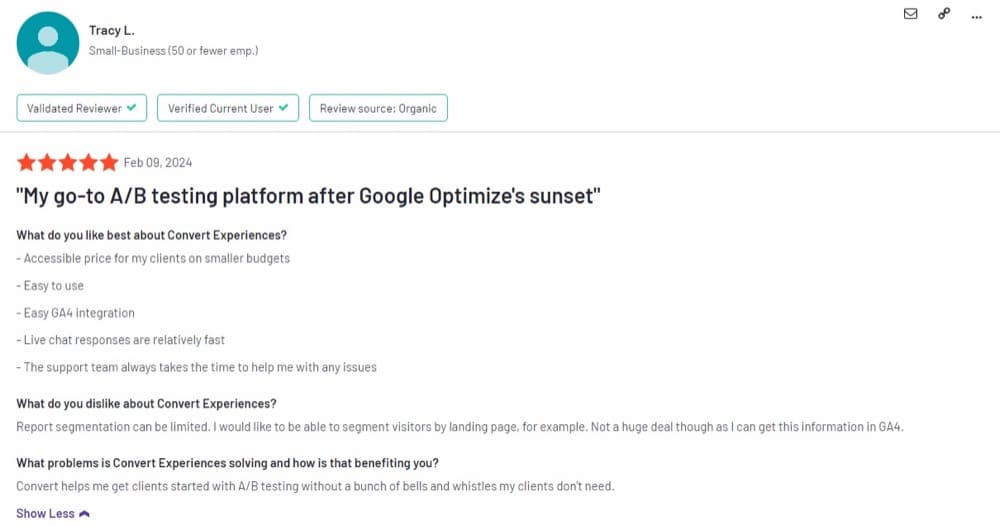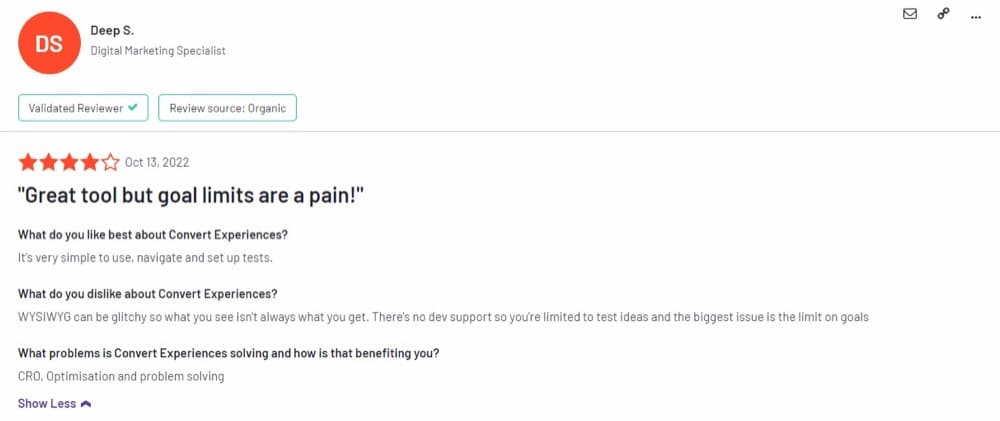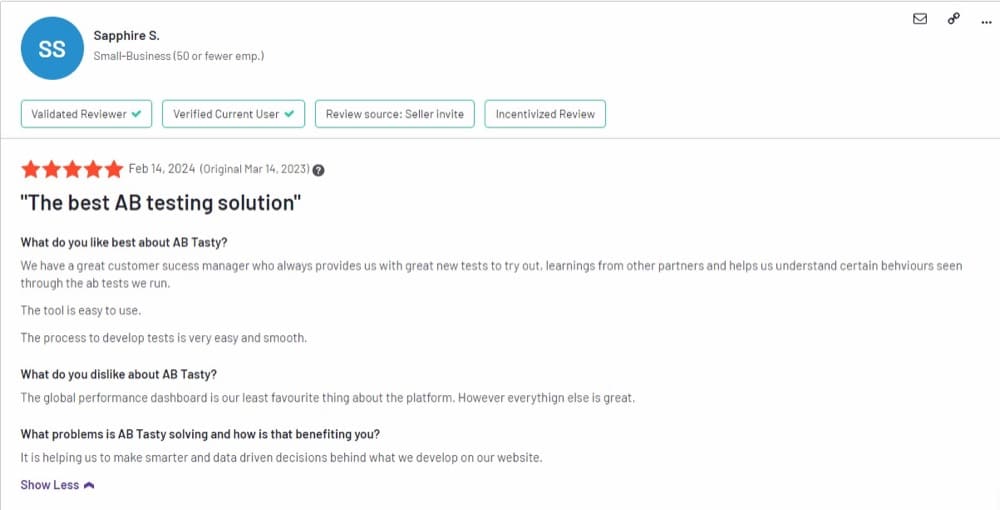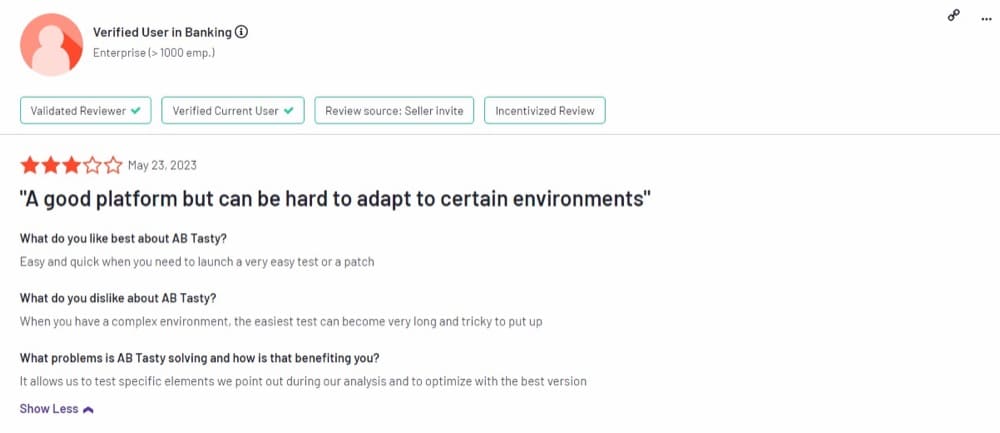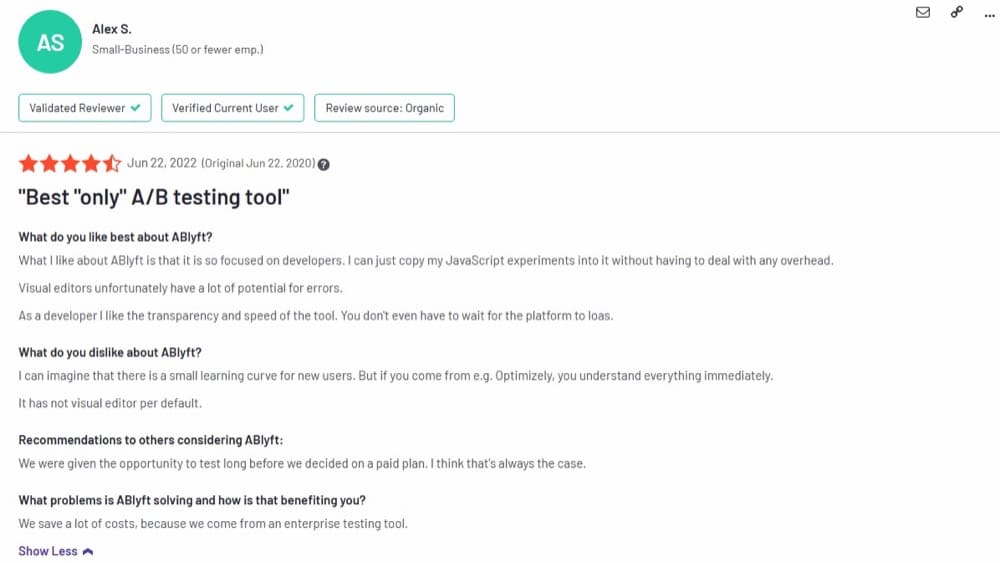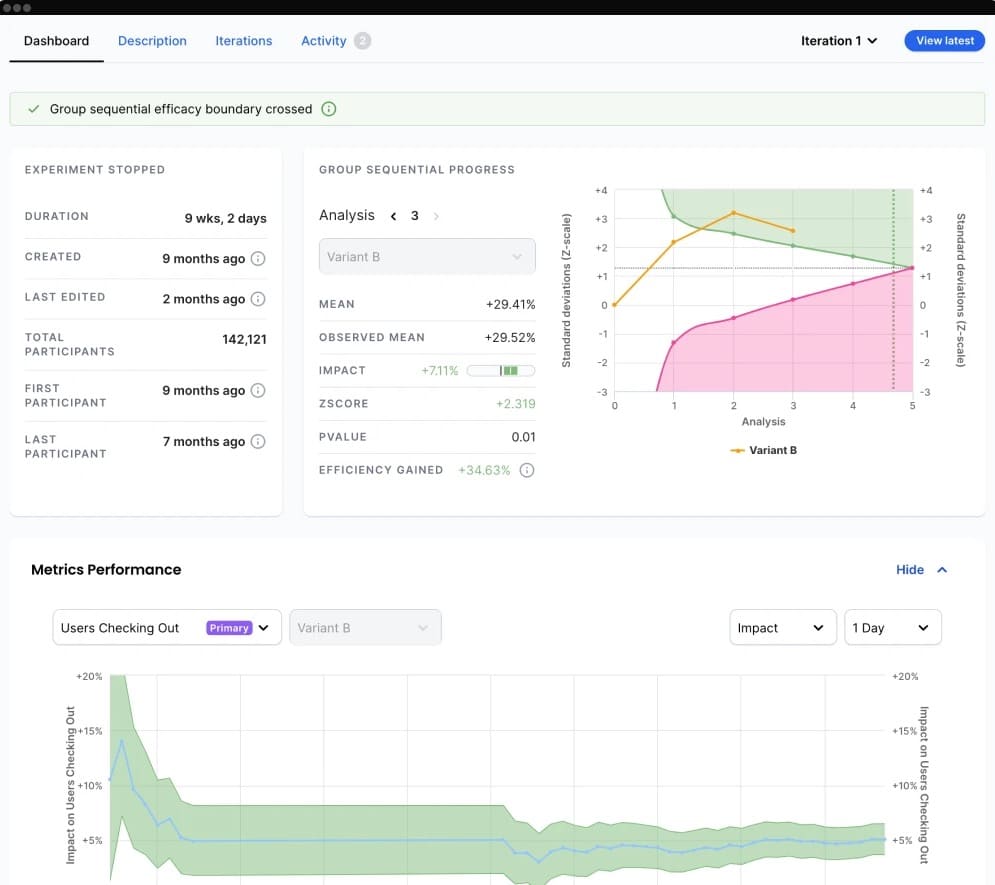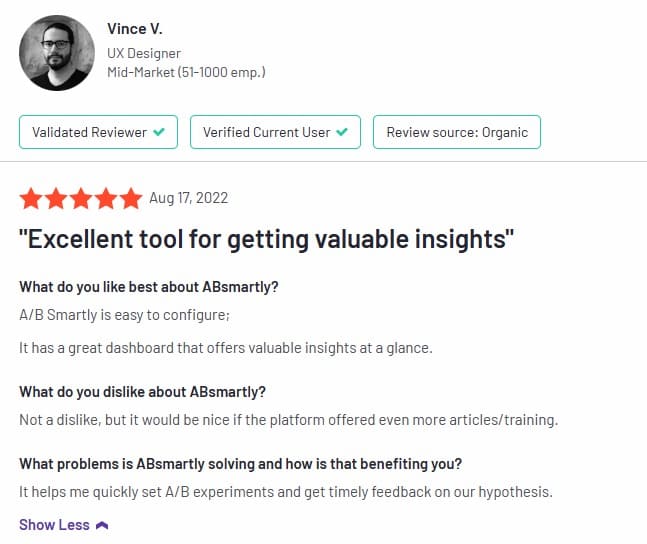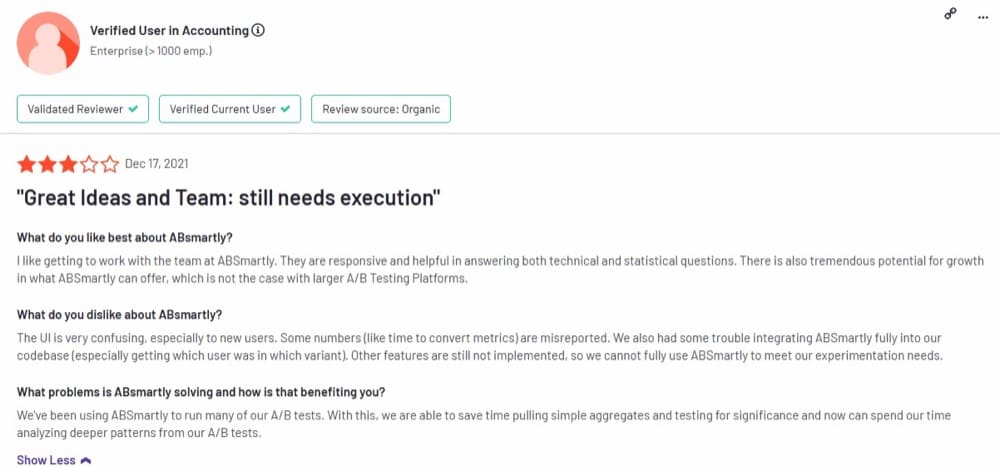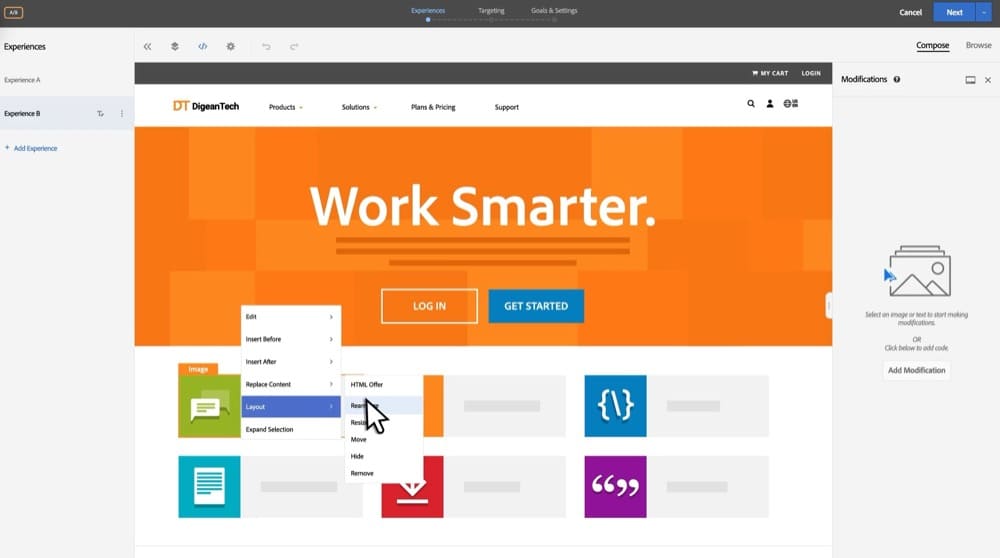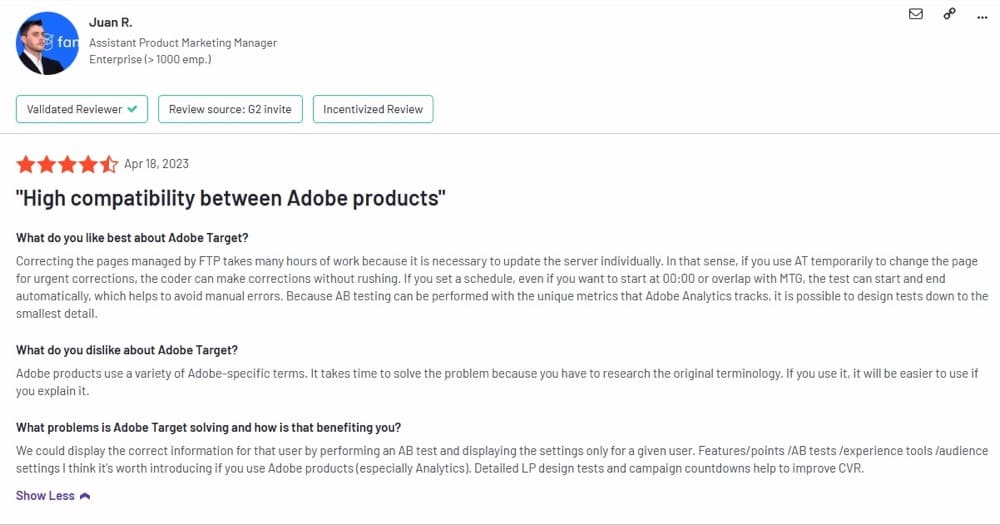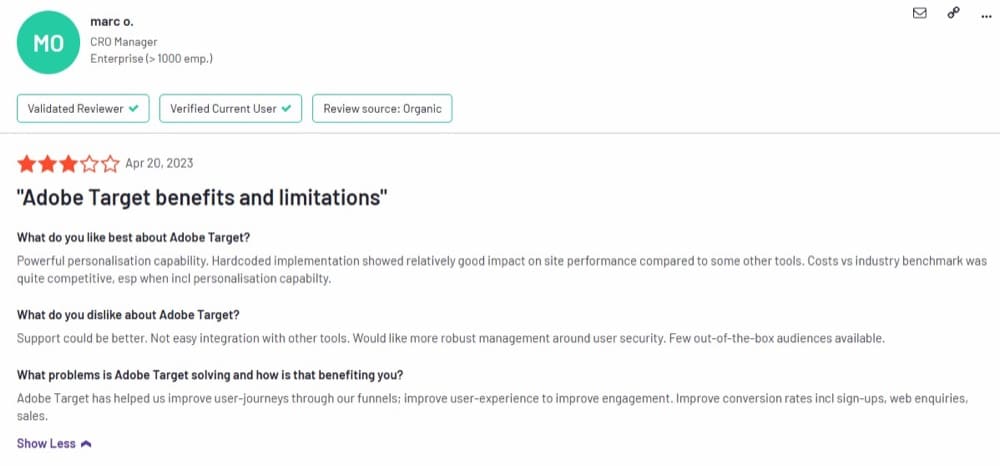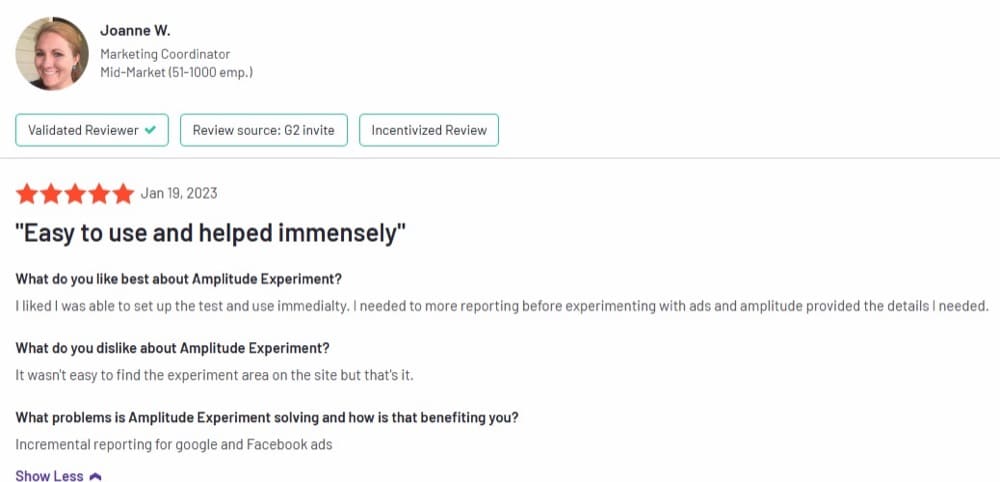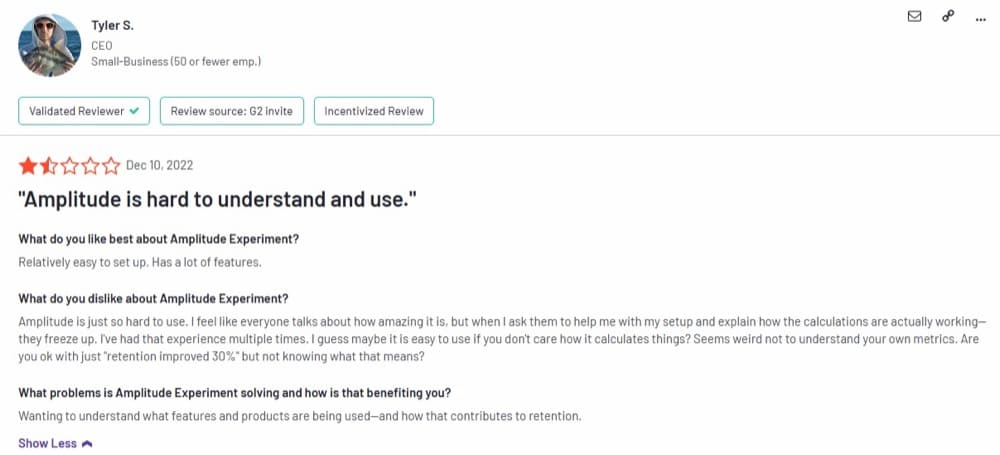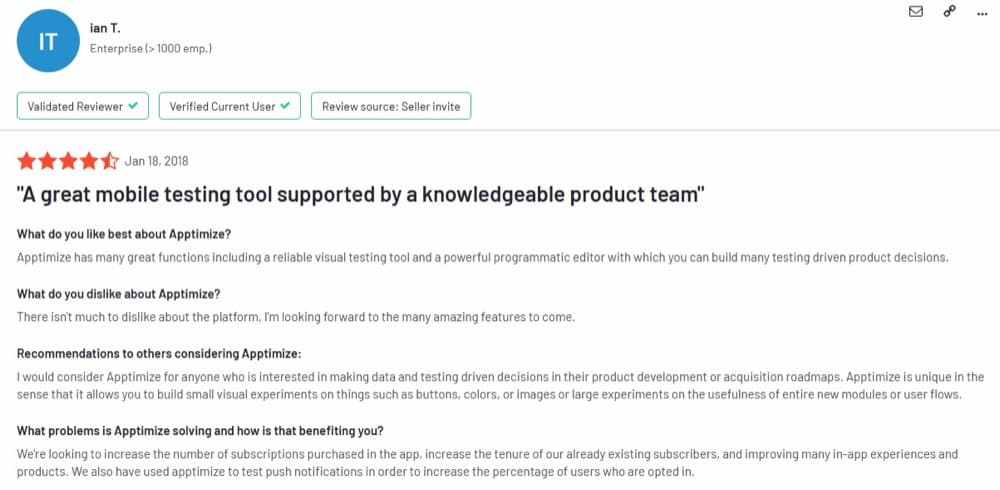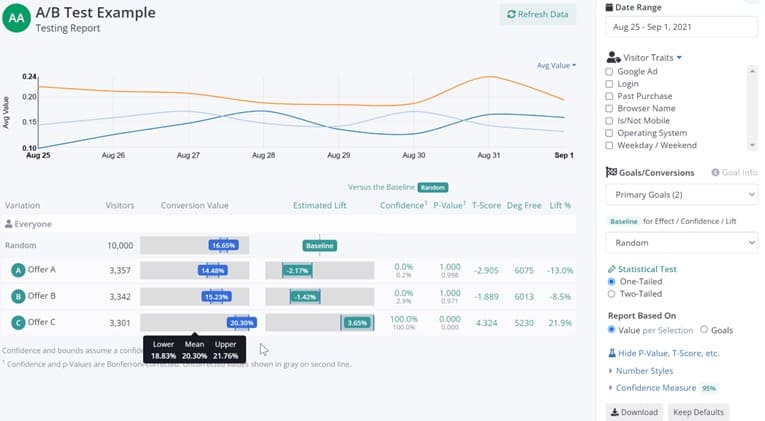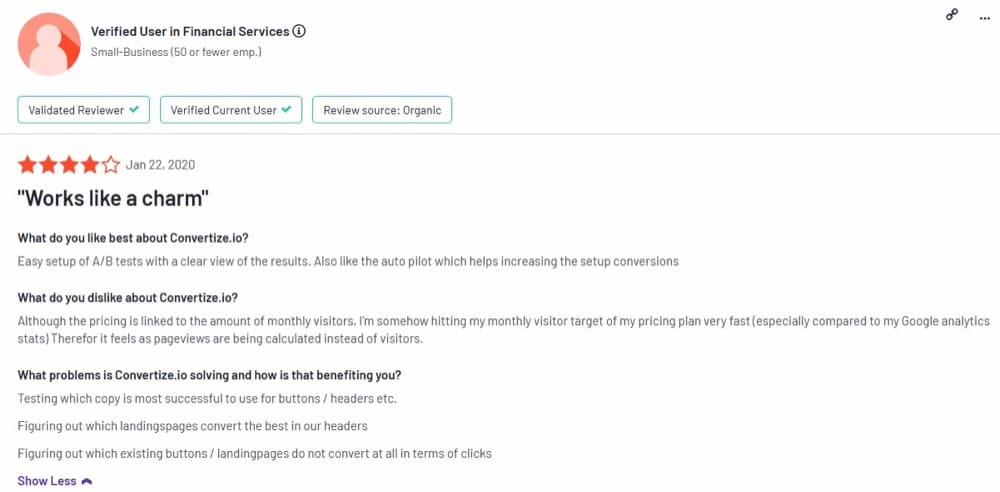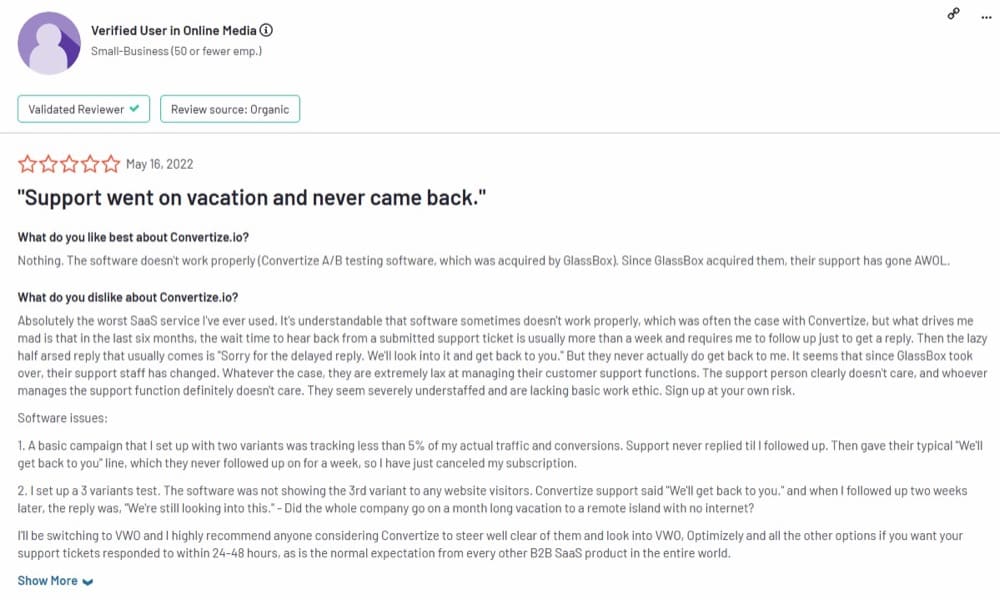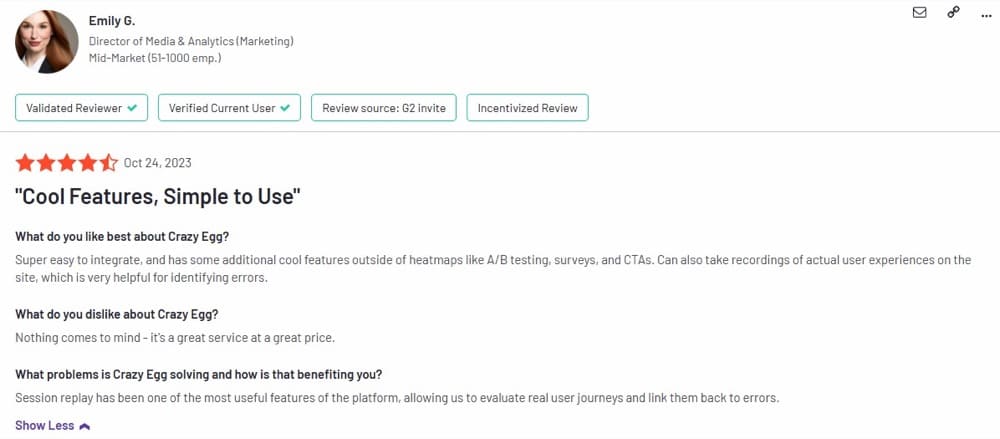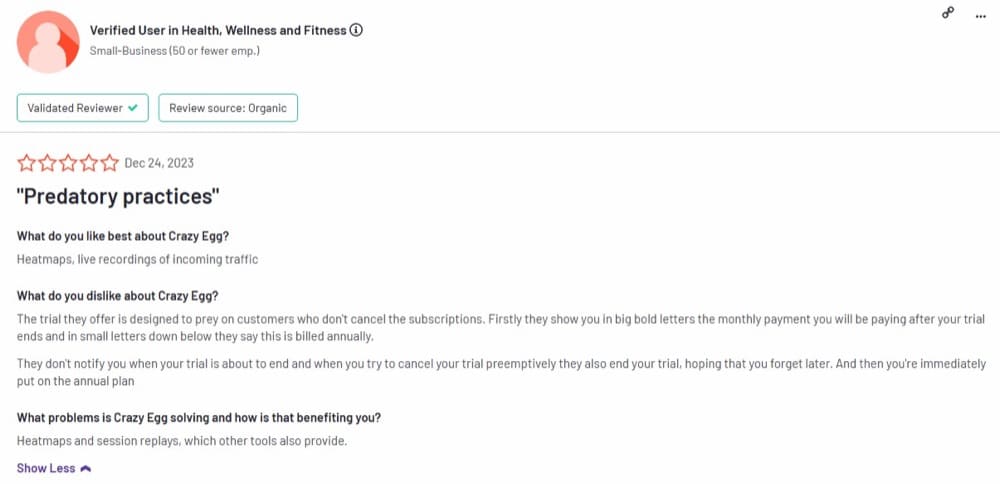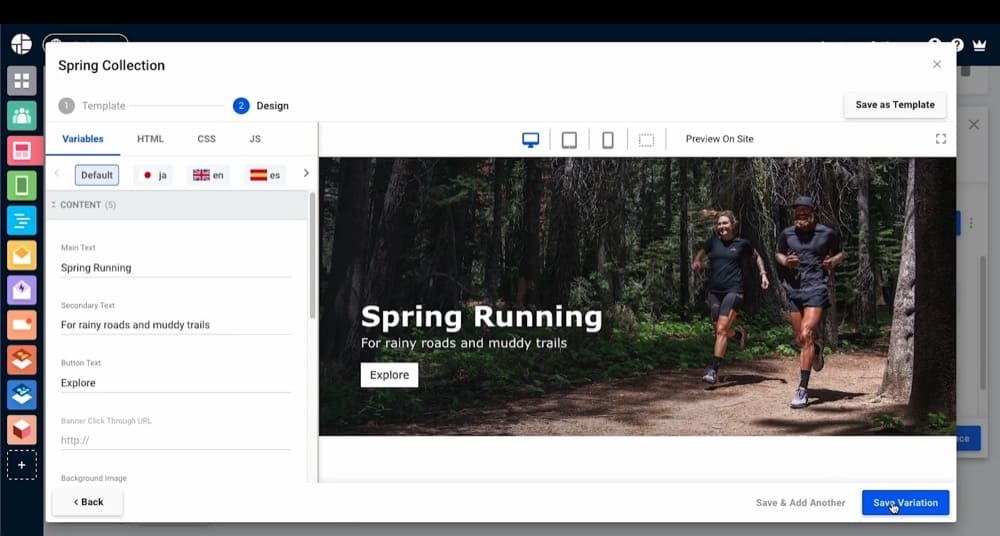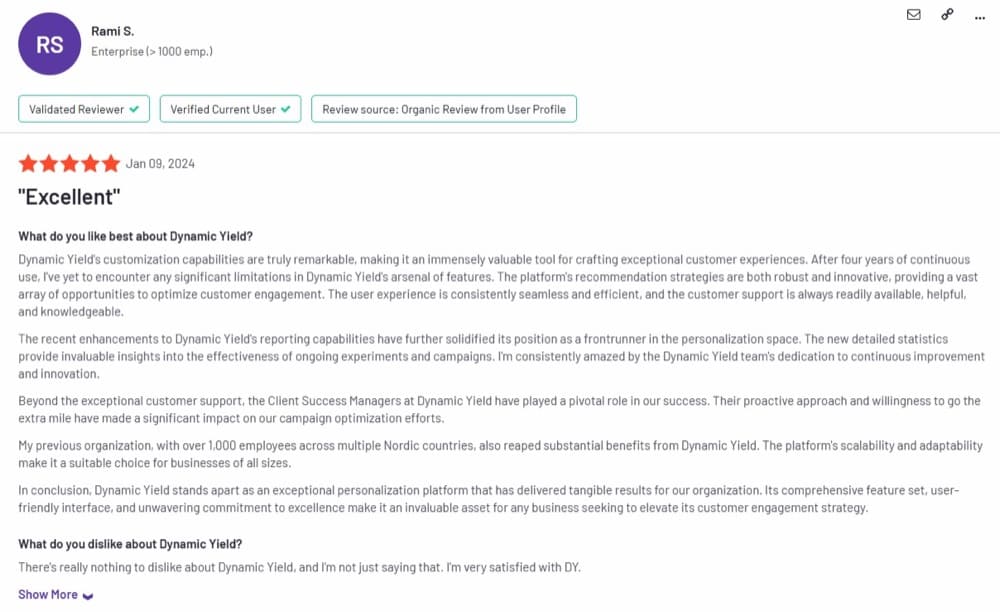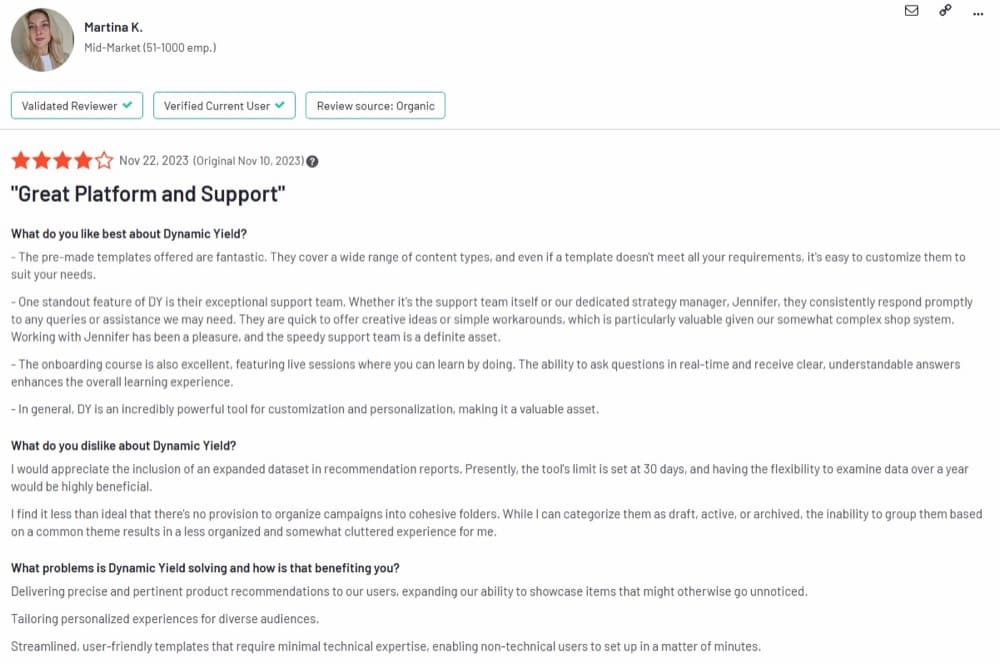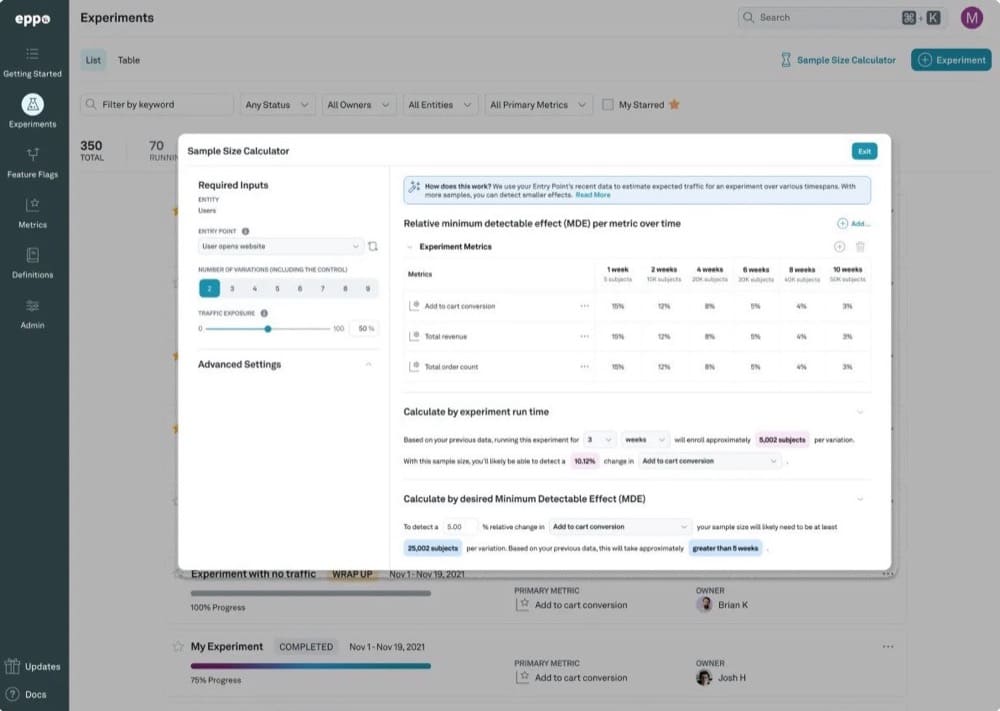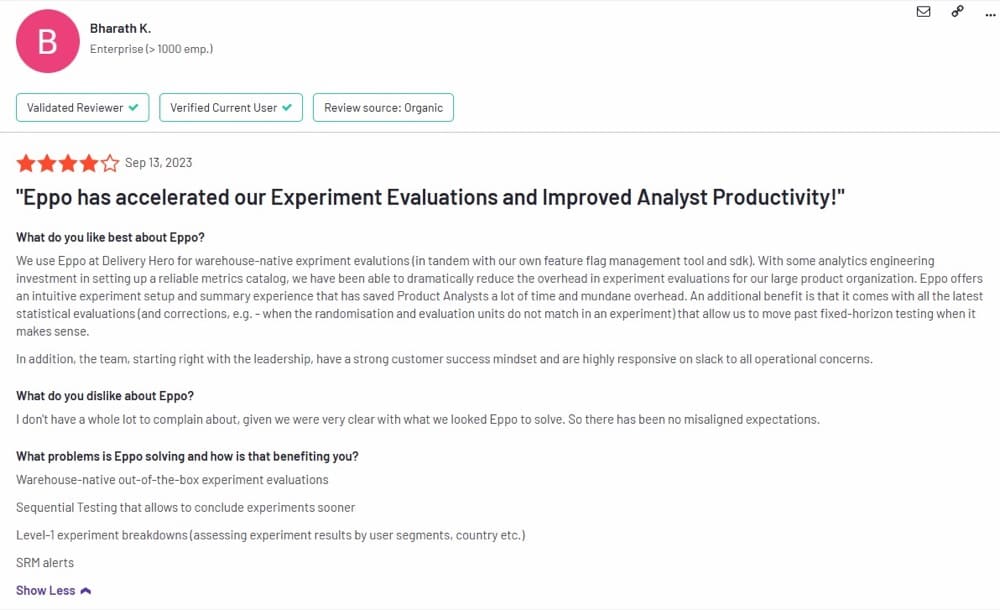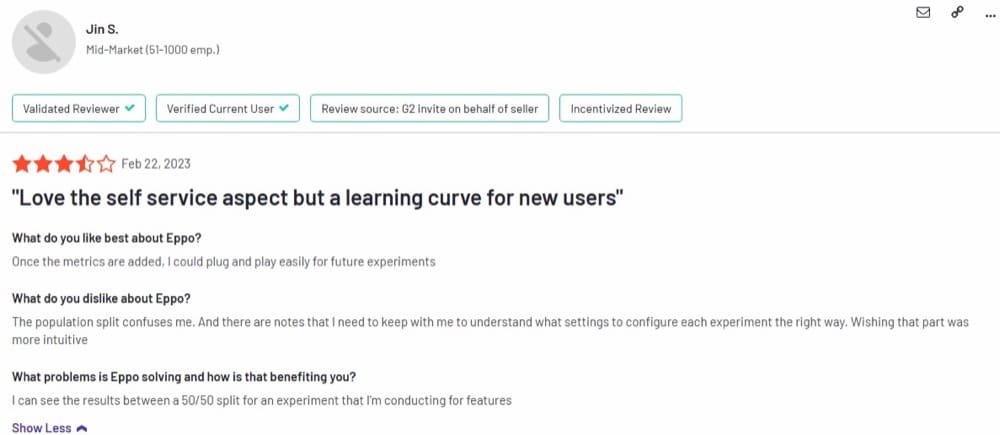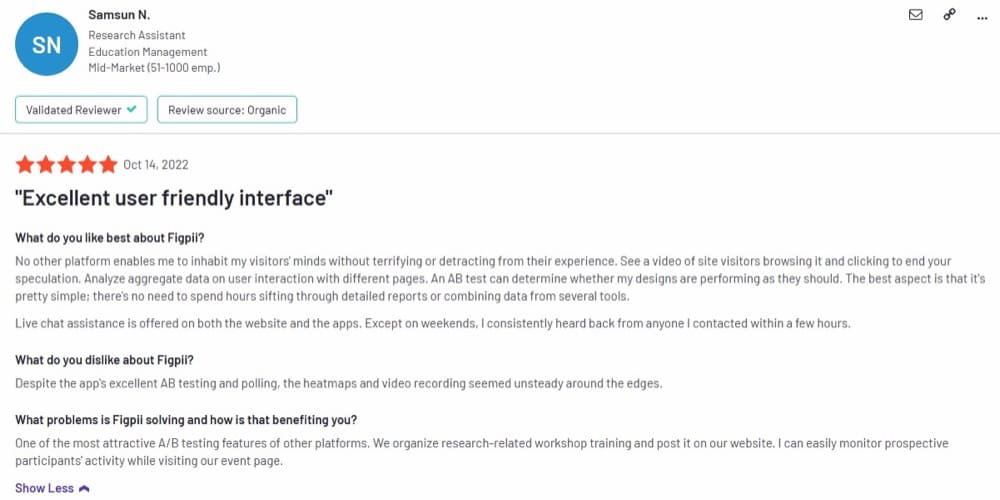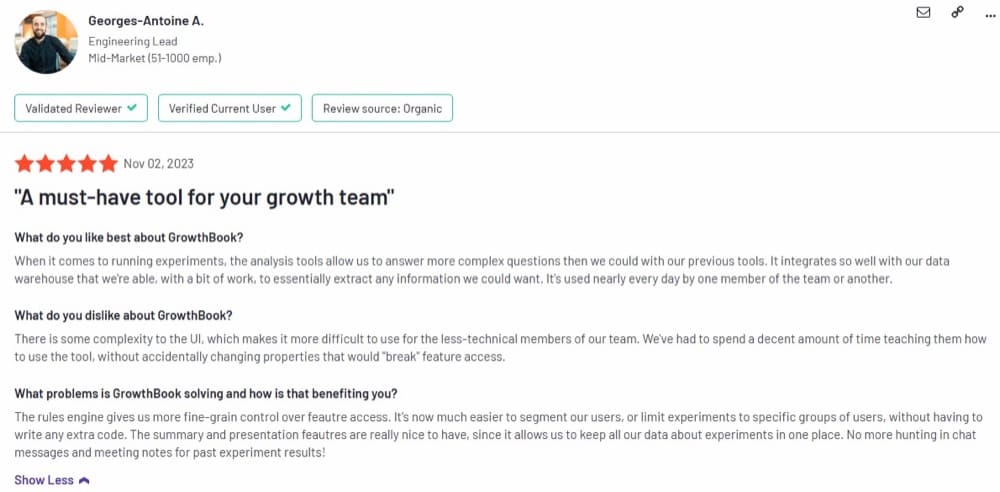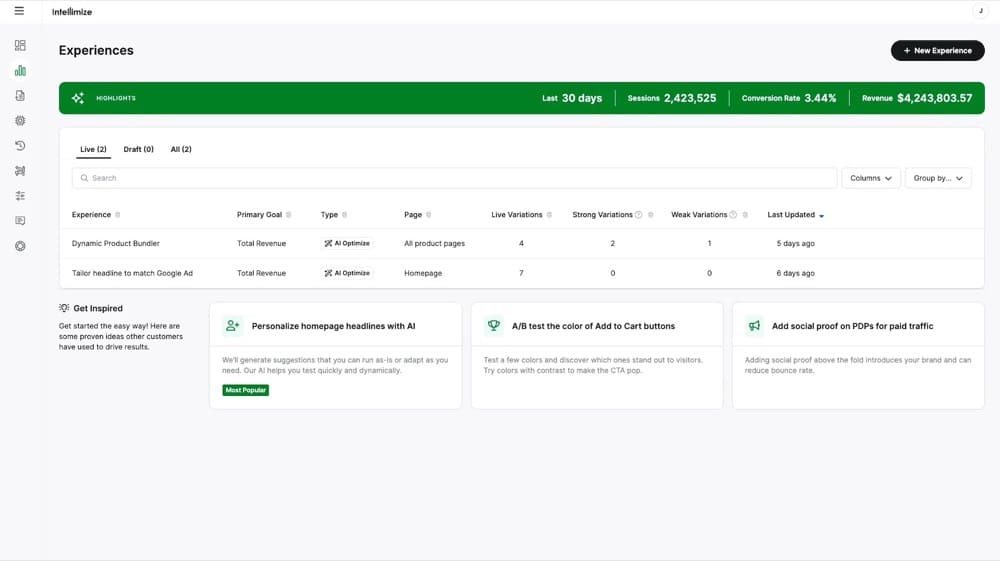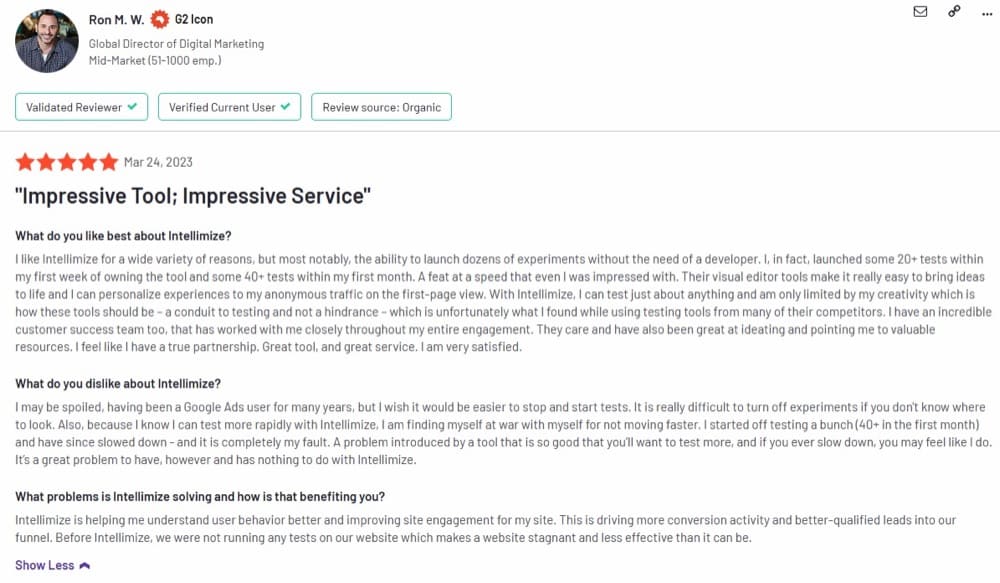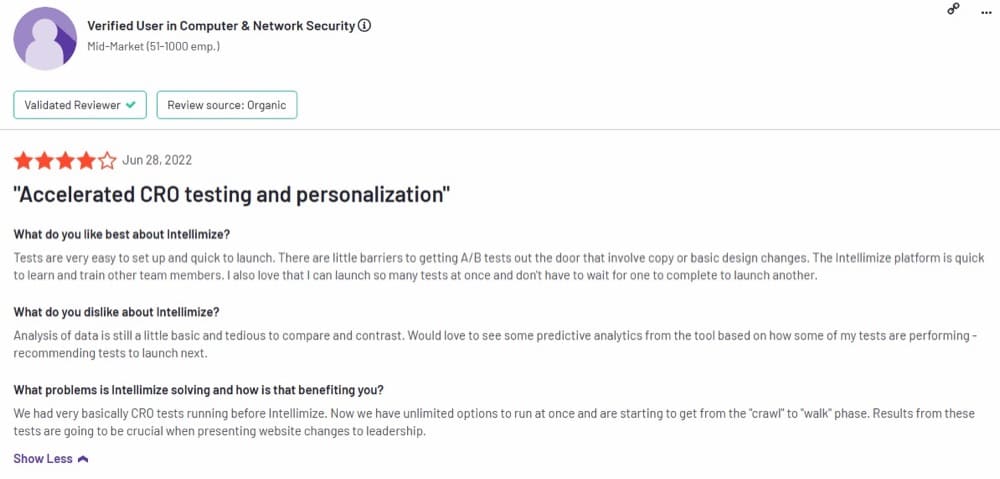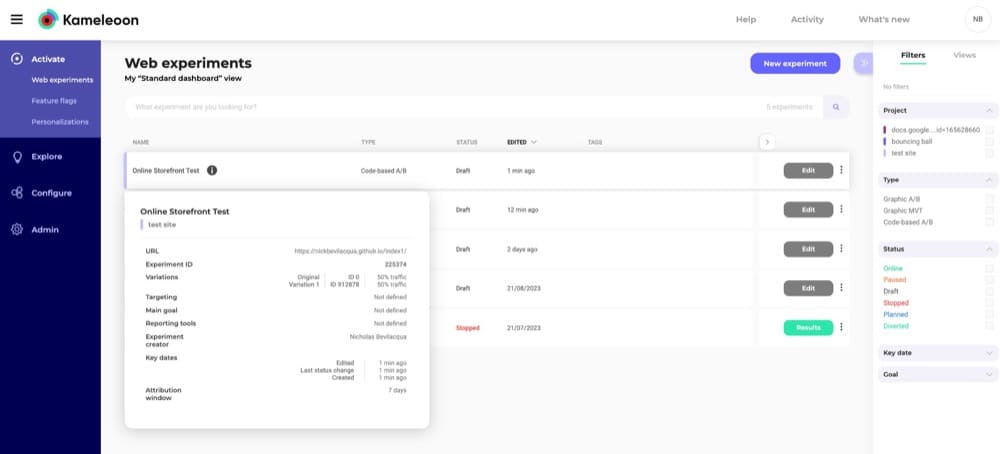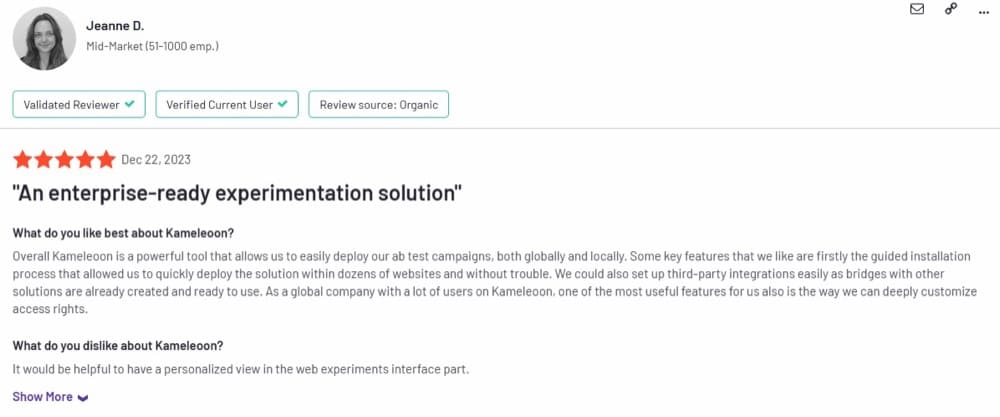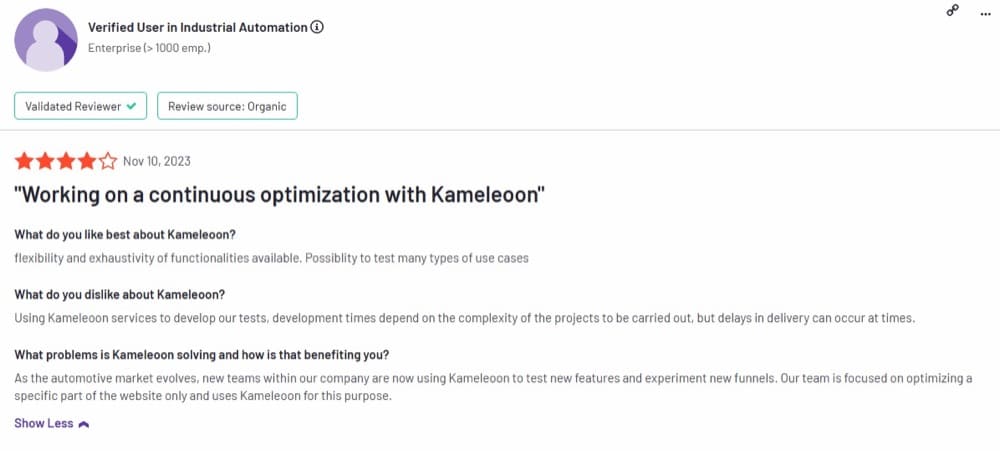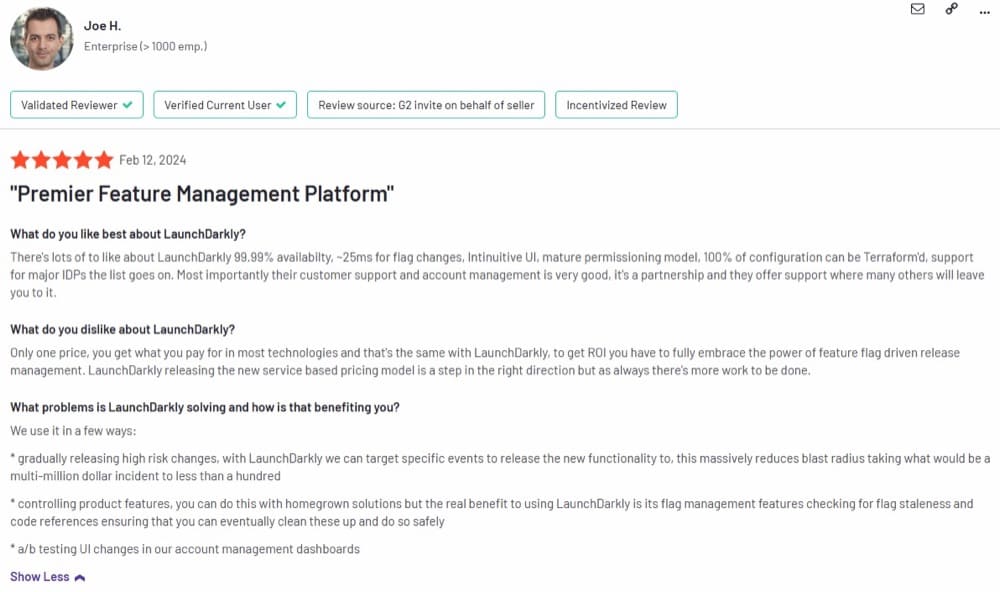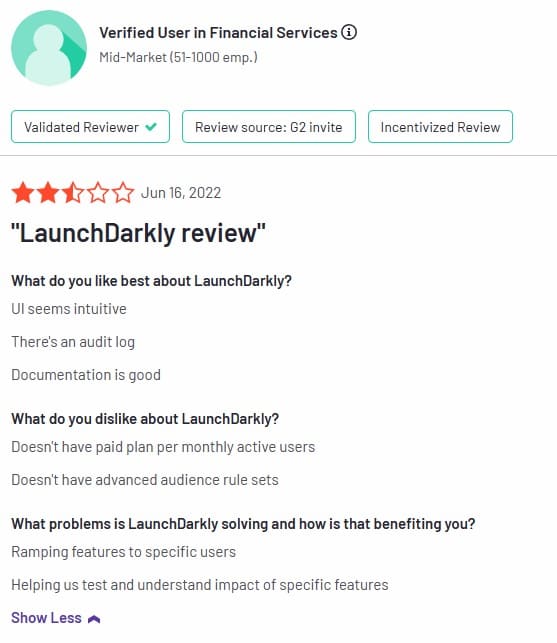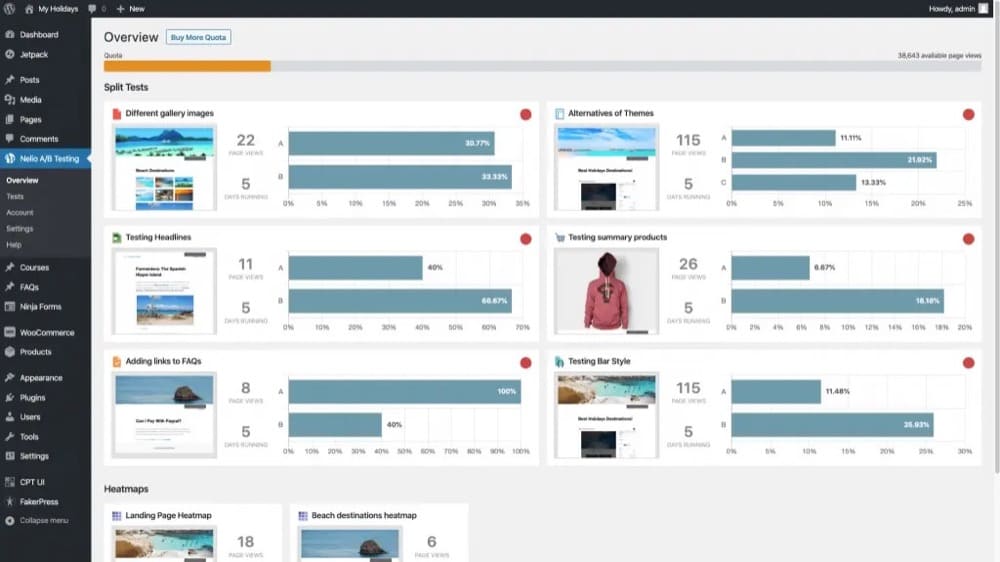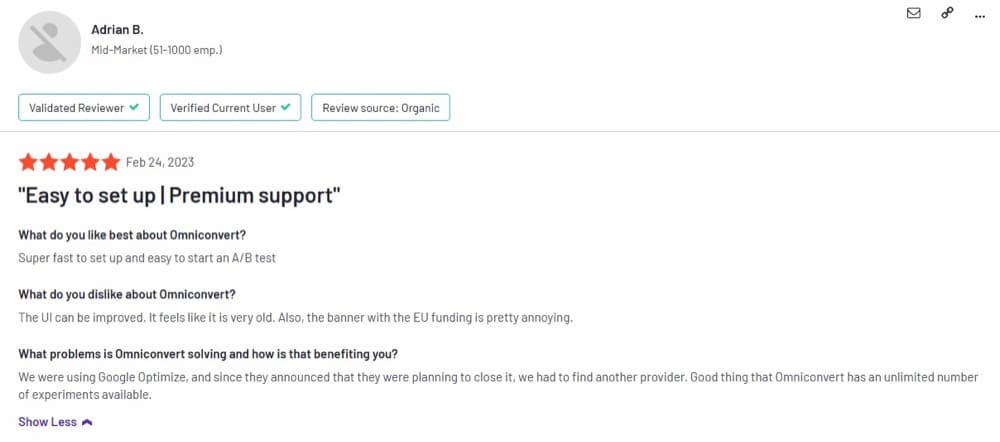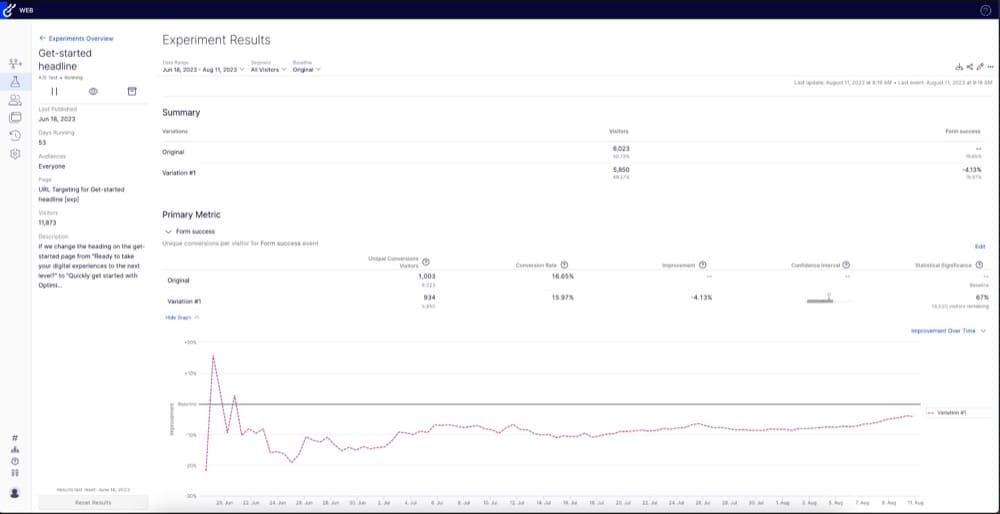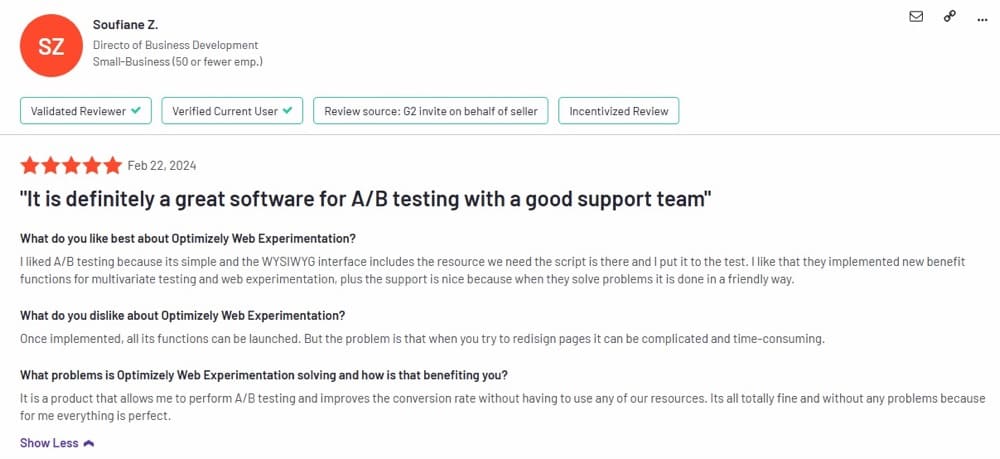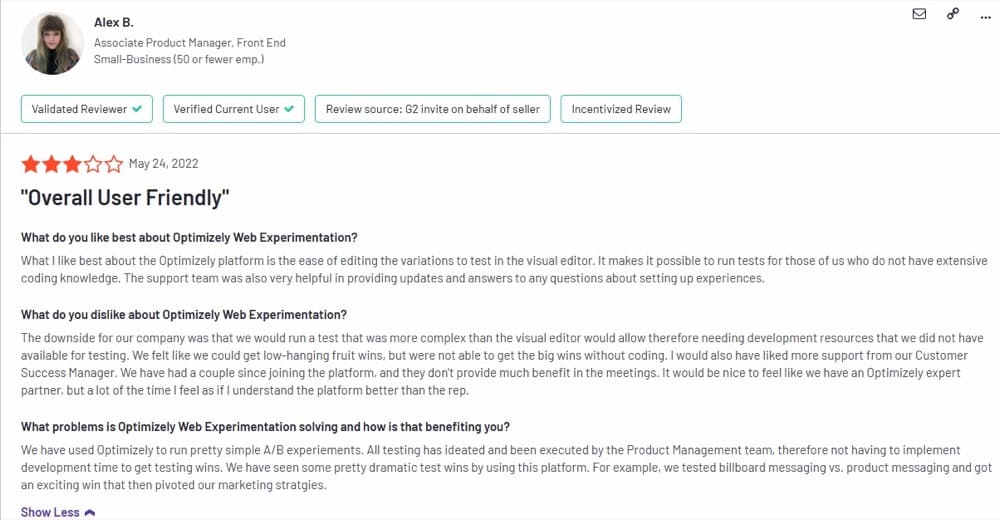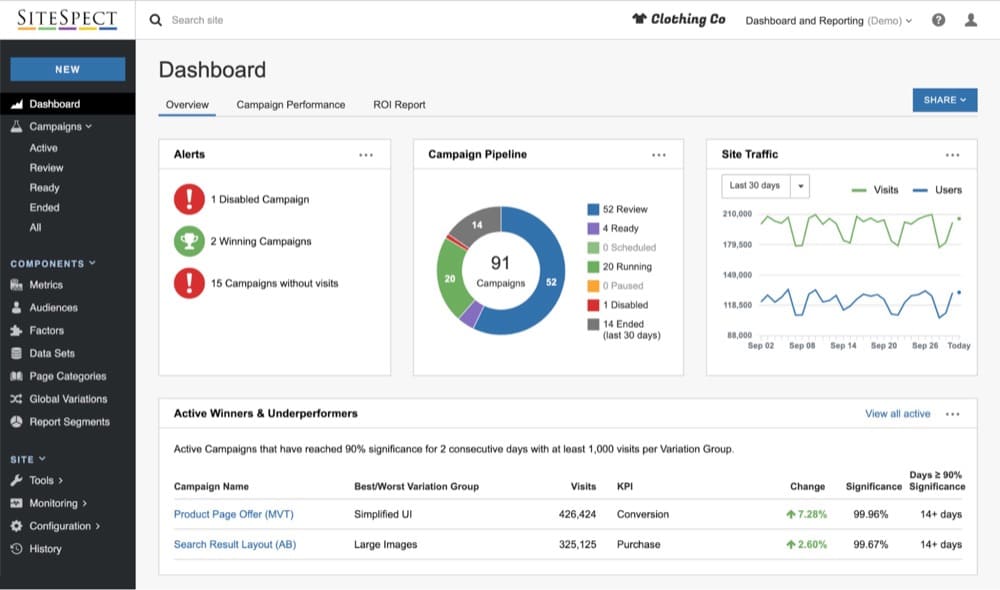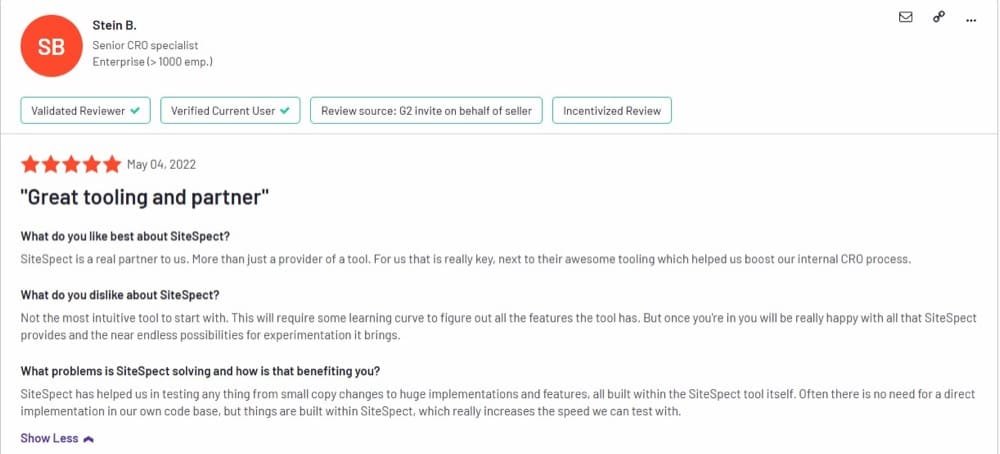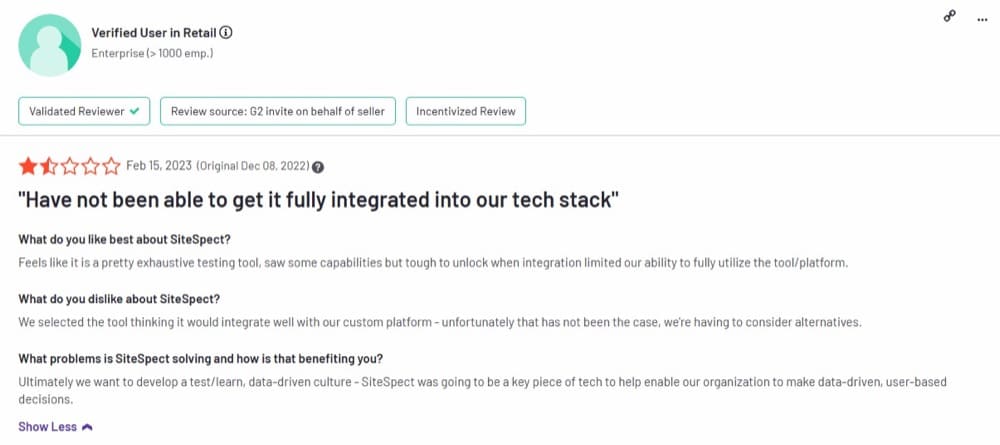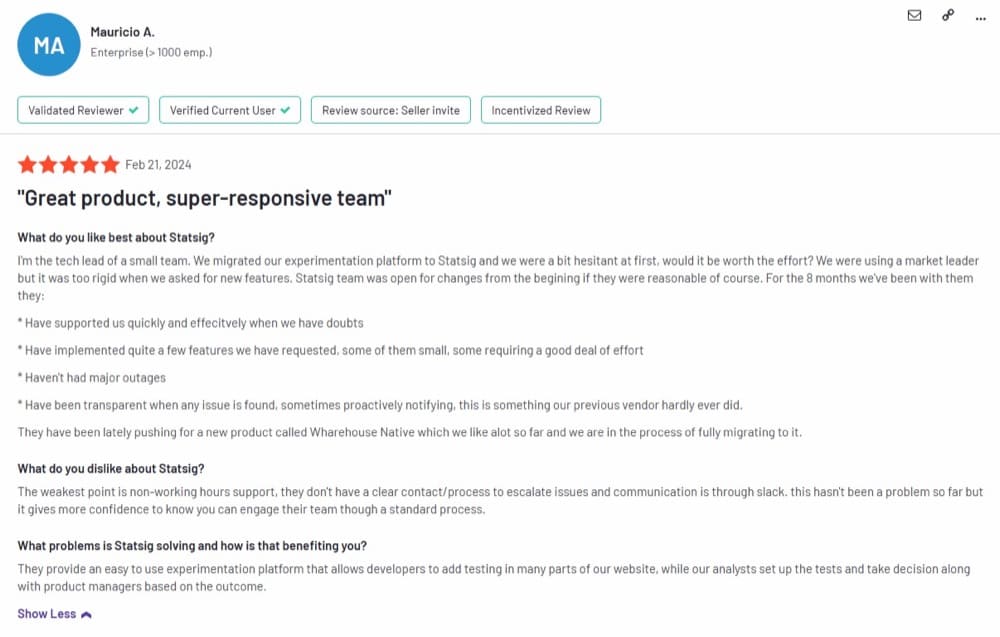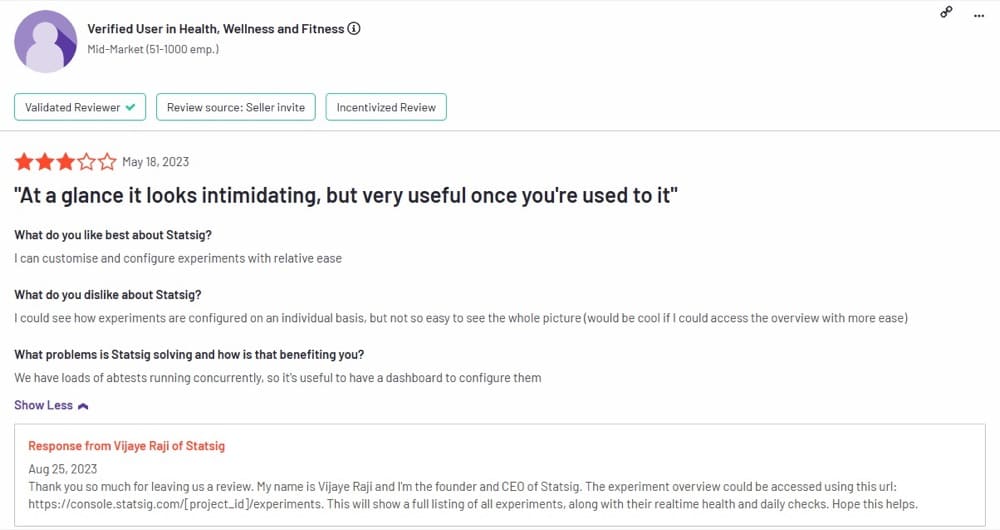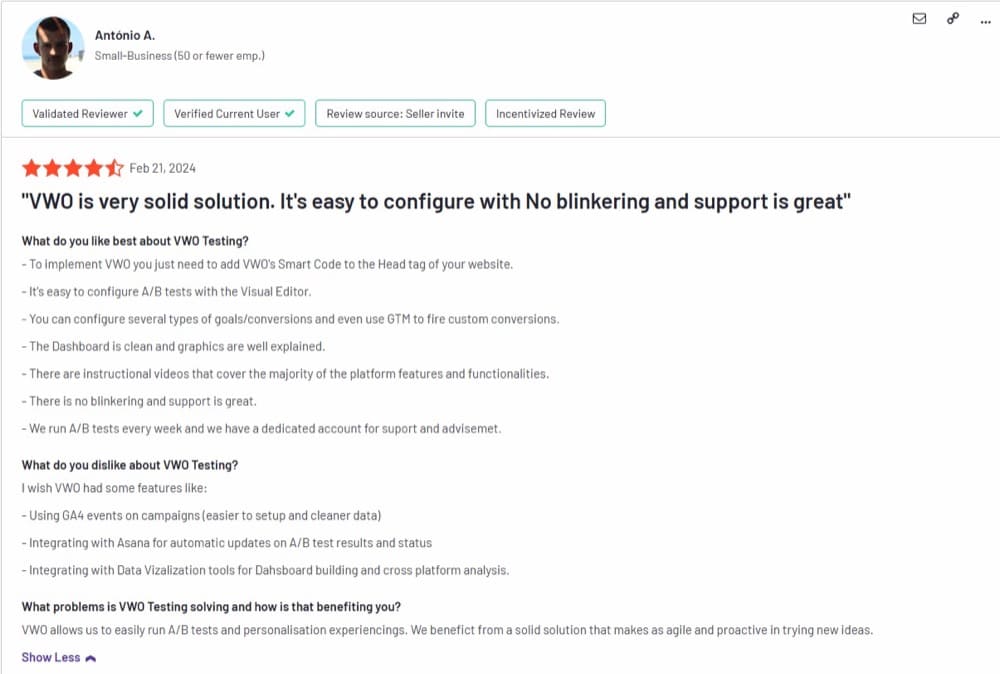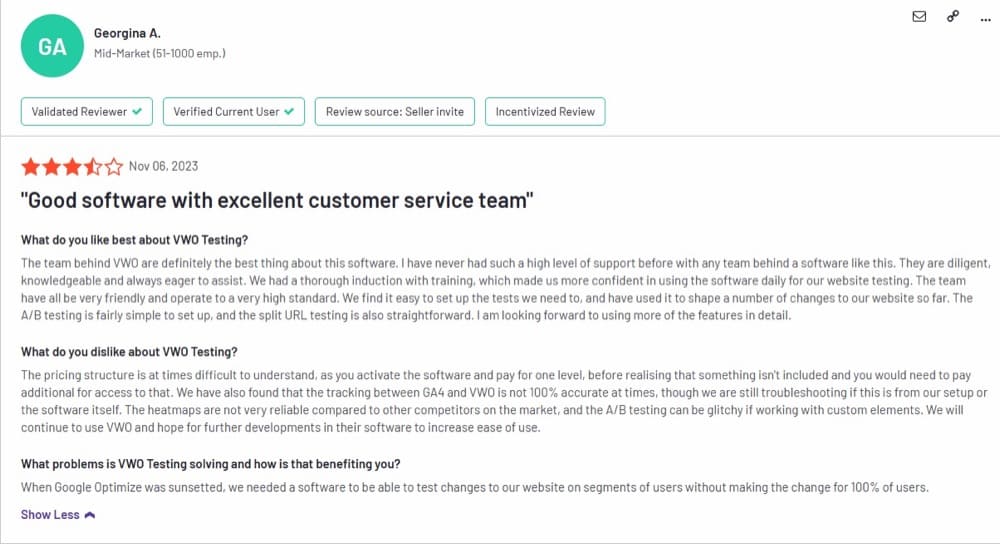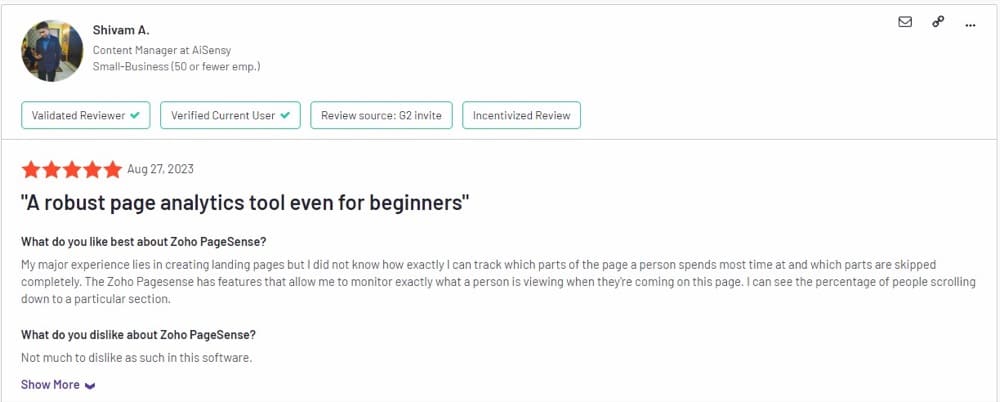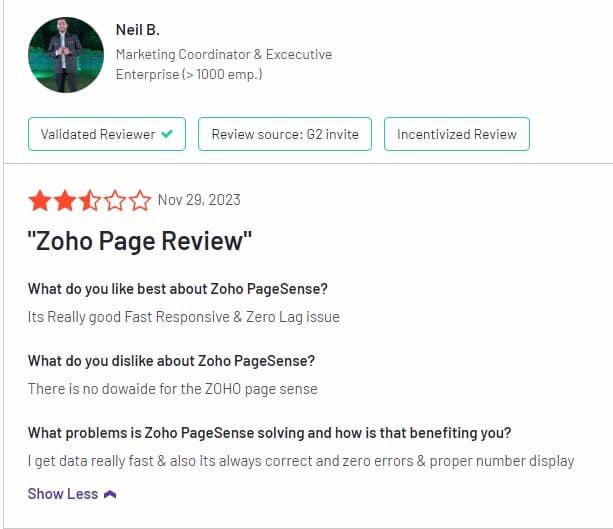Top 24 A/B Testing Tools for 2024

In searching for your perfect-fit A/B testing tool, simply comparing price tags and feature lists won’t cut it.
There’s more that’ll impact the quality of your experiments and the learnings you can pull from them. In this guide, we’ll take a closer look at the key things you need to consider, with input from seasoned conversion rate optimization pros. By the end of this guide, you’ll be able to invest in an A/B testing tool that dovetails seamlessly with your unique needs.
Here are the top 24 A/B testing tools we recommend:
- Convert Experiences
- AB Tasty
- ABlyft
- ABsmartly
- Adobe Target
- Amplitude
- Apptimize
- Conductrics
- Convertize.io
- Crazy Egg
- Dynamic Yield
- Eppo
- FigPii
- GrowthBook
- Intellimize
- Kameleoon
- LaunchDarkly
- Nelio
- Omniconvert
- Optimizely
- SiteSpect
- Statsig
- VWO Testing
- Zoho PageSense
We’ve added their features, how affordable they are, ideal use cases, and independent reviews. We judge how affordable an A/B testing tool is by the price of the tier that supports decent A/B testing.
We also added a sneak peek of each tool: A gif demo when a free trial is available and a screenshot of the UI when it isn’t.
Then, we cover the consciousness quotient (CQ) of the tool vendor. CQ measures how much a company or brand cares about its impact on the planet. Note: If there isn’t any CQ-related content published by the A/B testing tool company, it doesn’t automatically mean they don’t care about the world. They probably do and don’t talk about it.
Now let’s jump straight to the A/B testing tools comparison.
1. Convert Experiences
Convert Experiences is perhaps best considered as a mid-level testing platform but with one of the lowest price points. It is designed for companies and teams who are ready to scale up their testing program and processes.
Consistently recommended by agencies (even when they have a suite of competitors’ tools to use), Convert Experiences also has a fantastic support team for chat, email, and live calls.
G2 rating: 4.8/5 from 59 reviews
Ideal use case: Web and product experimentation
Pricing: It’s $499/mo for 100k visitors. This plan comes with unlimited tests, 10 active domains, 30 active goals/projects, and advanced post-segmentation.
What this A/B testing tool looks like in action:
Pros:
- Full stack testing is available in the basic $349/mo plan
- Supports both Frequentist and Bayesian stats
- Feature-rich, run unlimited tests
- Fully privacy compliant: no personal data is ever stored
- Supports SPA testing
- Reliable, fast customer support
Cons:
- No free starter plan, only a 15-day free trial
Integrations: Integrates with 90+ 3rd party tools (e.g. Shopify, WordPress, Mixpanel, Hotjar, Google Analytics)
Support: Live messaging, phone, email, and knowledge base with more to come.
AI roadmap: We currently have an AI Wizard that helps with writing copy, with plans to extend support to images and later to video. We aim to integrate Multi-Armed Bandit (MAB), a machine learning technique that enhances decision-making by adapting to new data and optimizing sensitive experiments to get optimal results faster.
Consciousness quotient (CQ): Caring about the world is in our DNA. We plant trees (our goal is 1,178,600 trees), run community programs, champion diversity from the initial application, donate to charities, and much more. We’re 15x carbon negative and aiming for 100x.
A/B testing software review from G2:
Most recent critical review:
2. AB Tasty
AB Tasty is a mid-level tool. It features a clean interface and simple setup, making it easy for companies looking to move past basic experimentation to start scaling their testing programs.
The simplicity extends into its machine learning functions to help large-traffic sites run more sophisticated personalization and data tracking.
G2 rating: 4.5/5 from 204 reviews
Ideal use case: Web, product, and app experimentation
Pricing: You find out when you submit a form.
A look inside AB Tasty:
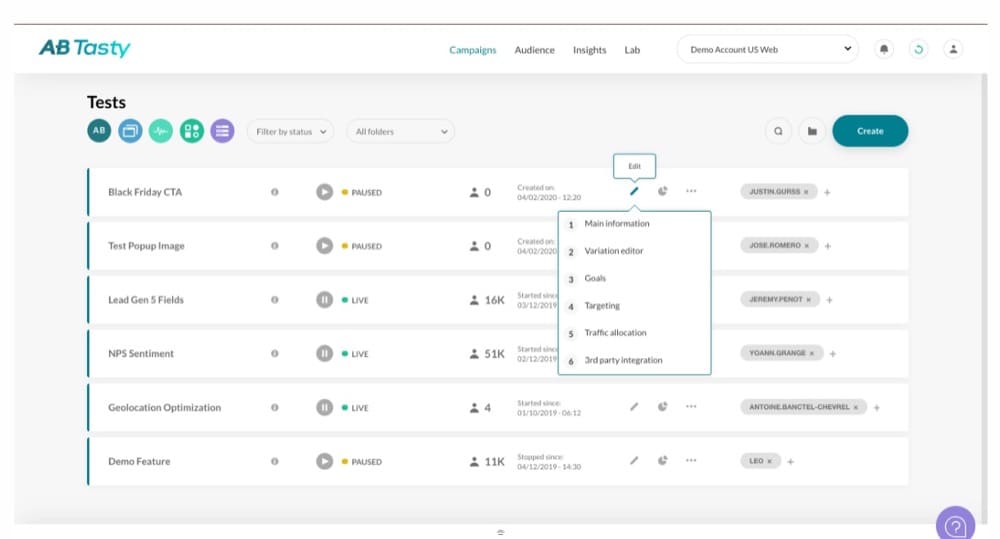
Pros:
- Built-in AI and ML capabilities
- Easy to set up and preview tests
- Multiple integrations
- Extensive analytics reports
- A wide range of targeting options are available, along with personalization
- Reliable customer support
Cons:
- Personalizations and tests tend to overlap or collide
- Data dashboards can be more user-friendly
- It is hard for non-technical users to set up Google Analytics tracking
Support: Knowledge base and live chat.
AI roadmap: AB Tasty uses AI to automate parts of the optimization workflow and help with personalization and analytics.
Consciousness quotient (CQ): They donate to NGOs, work with social action groups, recycle, and sponsor beehives.
A/B testing software review from G2:
Critical review:
3. ABlyft
ABlyft is an A/B testing platform that supports web, mobile app, and product experimentation. Built by experienced testing engineers and managers, it has a strong focus on developers.
It also integrates with various analytics tools.
G2 rating: 4.5/5 from 1 review
Ideal use case: Web experimentation
Pricing: Custom pricing, after a free trial.
What ABlyft looks like in action:
Pros:
- Supports single-page application (SPA) experimentation
- Comes with mutual exclusion to prevent experiment overlap
- Fast, lightweight snippet
Cons:
- There’s a learning curve for a beginner who just wants to run simple experiments
Support: Support tickets are available
AI roadmap: At the time of writing this, I did not find information about AI features or plans for those features.
Consciousness quotient (CQ): Found no information about what ABlyft does to benefit the world.
A/B testing software review from G2:
Critical review:
There’s only one review available for ABlyft on G2 and it’s positive.
4. ABsmartly
ABsmartly is a private cloud A/B testing tool designed to run experiments faster than most tools. It allows you to test on any platform—web, SaaS product, mobile app—both client-side and server-side.
The tool is optimized for high throughput, supporting many experiment types, goals, and multi-variate testing.
G2 rating: 4.6/5 from 13 reviews
Ideal use case: Cross-platform A/B testing: Mobile apps, SaaS products, websites
Pricing: 60-day PoV (proof of value) is available and then it’s custom pricing
A look inside ABsmartly:
Pros:
- ABsmartly is designed to be a fast tool
- It sets no limits on experiments, users, and goals
- The SDK is easy to work with (both frontend and backend)
- Support is fast
Cons:
- Exporting data requires help from the support team
- Metric table fields can be hard to read
Support: Documentation, training sessions, and email support are available
AI roadmap: Did not find information about AI features or plans for those features.
Consciousness quotient (CQ): Found no information on this.
A/B testing software review from G2:
Critical review:
5. Adobe Target
Adobe Target is a powerful enterprise testing tool but it does come with some limitations, in that it’s only available to customers of their analytics tool.
That being said, the integration between the two allows for a fantastic workflow switching between personalization and segment targeting (hence the name), especially when you factor in its machine learning capabilities to constantly learn more about your audience and targeting.
G2 rating: 4.1/5 out of 62 reviews
Ideal use case: Personalization and experimentation
Pricing: Only available after an 11-part form, an email, and a call.
A look inside Adobe Target:
Pros:
- The interface is easy to use
- Provides accurate real-time data reports
- Integrates well with Adobe Analytics and is designed as an upsell offer
- Website personalization tools for both beginners and experts
- Walks you through the setup and testing process
- Has advanced AI to continually test and improve campaigns and personalization
- Can get great insights when connected to other paid Adobe Marketing Cloud tools
Cons:
- Optimizing on a large scale can be slow
- Requires a very high volume of traffic to work best
- The form-based editor has a learning curve
- High price point
- No trial option
Support: A knowledge base, video training programs, phone and chat support, and an expert community are available.
AI roadmap: Adobe Target allows you to personalize your visitors’ experiences with AI at scale.
Consciousness quotient (CQ): They champion diversity, work towards 100% renewable energy buildings, lower emissions, run community action programs, and more.
A/B testing software review from G2:
Critical review:
6. Amplitude
Amplitude is a digital analytics platform that’s built for product innovation and experimentation. It provides a way for businesses to make the right bets, by connecting products to actual business outcomes. This is through its product analytics, event tracking, and experimentation features.
G2 rating: 4/5 from 12 reviews
Ideal use case: Product experimentation and analytics
Pricing: Starts free and then it’s $61/mo. But you can only run A/B tests and MVTs on the growth plan which requires you to contact sales for pricing.
What this Amplitude looks like in action:
Pros:
- Session replay and unlimited feature flags are on the free plan
- It’s got built-in data quality checks
- The workflow-based design makes you follow best practices of experiment design for statistical rigor
- It has personalization features
Cons:
- A/B testing is only available from the third pricing tier
- There’s an initial learning curve
- Amplitude support is limited
Support: There’s a help center, live chat, ticket/email support, and learning resources.
AI roadmap: Amplitude AI features a suite of AI-powered features for automating data management, generating insights, monitoring product metrics changes, and providing recommendations and predictions.
Consciousness quotient (CQ): Didn’t find information on Amplitude’s CQ.
A/B testing software review from G2:
Critical review:
7. Apptimize
Apptimize is an Airship company that’s arguably the leading solution for mobile A/B testing and feature release management. Brands use it to build and iterate on user experiences across their digital channels—all in a mobile-first approach.
G2 rating: 4.1/5 from 17 reviews
Ideal use case: Cross-platform A/B testing: Mobile apps, SaaS products, websites
Pricing: Starts free and the rest is custom pricing
What this A/B testing tool looks like in action:
Pros:
- Fast and reliable testing on mobile apps
- Bypasses App Store and Play Store
- Apptimize has a patented technology stack that integrates with major push and analytics providers
Cons:
- Not beginner friendly
- Developer-centric design
Support: Live chat, email, and documentation are available.
AI roadmap: Did not find information about Apptimize’s AI features or AI plans.
Consciousness quotient (CQ): Found no information on CQ.
A/B testing software review from G2:
The most recent reviews here are old (2018).
Critical review:
I found none worth noting.
8. Conductrics
Conductrics is a unified customer experience platform—you get testing with machine learning and surveys. It’s built in such a way that you’ll learn the “what” and “why” behind your customer behavior in one platform.
G2 or TrustRadius rating: N/A
Ideal use case: Cross-platform A/B testing and user research
Pricing: Custom pricing
A look inside Conductrics:
Pros:
- Has WYSIWYG and code editor
- You can set up tests using custom JS, page redirects, or rich APIs
- The ML predictions identify audiences of interest
Cons:
- No free trial
Support: Email support and password-protected documentation are available.
AI roadmap: Conductrics Predict uses AI and ML to recommend a variation to the audience segment that prefers it.
Consciousness quotient (CQ): No CQ info found for Conductrics.
9. Convertize.io
Convertize.io is a beginner-friendly testing tool for running A/B tests on various elements on your web pages. Beyond testing, it suggests optimization approaches based on research and previous test data. This gives you more certainty about your next steps when you’re new to CRO.
G2 rating: 3/5 from 4 reviews
Ideal use case: Web experimentation
Pricing: Starts with a 14-day free trial, and then it’s $59/mo for 20k visitors and all the features.
What Convertize looks like in action:
Pros:
- Great pricing for companies new to A/B testing
- Easy to install and use, especially for a beginner
- Has a great visual editor
- Provides 150 testing ideas to get you started
Cons:
- There are some issues with the global JavaScript box
- Analytics features are not advanced enough for some users
Support: Chat and email support.
AI roadmap: Not exactly AI, but Convertize has an advanced multi-armed bandit algorithm called Autopilot that automates A/B tests for maximum conversions.
Consciousness quotient (CQ): Nothing about CQ was found for this A/B testing tool.
A/B testing software review from G2:
Critical review:
10. Crazy Egg
Crazy Egg is a behavior analytics tool that’s valuable for ecommerce businesses looking to understand the browsing experience of their visitors. While being beginner-friendly in how the features are made available to you, you can get overwhelmed by the many options.
But if your focus is only on A/B testing, Crazy Egg does a good job of helping you create variants, run simple tests, and generate reports.
G2 rating: 4.2/5 from 110 reviews
Ideal use case: Web experimentation and behavioral analytics
Pricing: After a 30-day free trial, you can conduct unlimited A/B tests for $49/mo (must be paid annually, so it’s actually $588/yr).
What Crazy Egg looks like in action:
Pros:
- Simple to set up and run A/B tests
- Has click mapping, scroll mapping, and heat mapping features
- Has a powerful segmentation feature
Cons:
- Lots of features that are difficult for some users to use fully
- Reports aren’t detailed enough
- A user reports they use deceptive tactics to lock customers into annual subscriptions (see review below).
Support: Knowledge base, video tutorials, and support tickets.
AI roadmap: Did not find information about AI features or plans to build them.
Consciousness quotient (CQ): Nothing about CQ was found for this tool.
A/B testing software review from G2:
Critical review:
11. Dynamic Yield
Dynamic Yield is another enterprise-focused experimentation platform.
Ideal for very high volume sites, it offers A/B testing, omnichannel personalization, and predictive test improvements via machine learning along with many other features.
Because of this, however, it’s not ideal for beginners or testers on a budget.
G2 rating: 4.5/5 from 137 reviews
Ideal use case: Cross-platform A/B testing and personalization
Pricing: Custom pricing.
A look inside Dynamic Yield:
Pros:
- Has advanced personalization capabilities to run predictive targeting of messages to your audience.
- Full stack integration
- Omnichannel testing and tracking
- Fantastic support and education
Cons:
- Can be overwhelming to set up due to the large number of options
- Some essential features require developer setup assistance
- Not the best integration with analytics
Support: Call and email support, along with a basic knowledge base are available.
AI roadmap: The tool uses AI for predictive targeting, content customization, and product recommendations.
Consciousness quotient (CQ): They do something very cool, which is to offer free use of their tool to charities that meet certain criteria. They also do work in the community.
A/B testing software review from G2:
Positive review with some criticism:
12. Eppo
Eppo is a low-code end-to-end experimentation platform that supports advanced A/B testing on product features without hard-coded scripts. It’s designed to make experimentation accessible to more people in an organization, through no-jargon reports and abstracted statistical details of experiments.
G2 rating: 4.8/5 from 34 reviews
Ideal use case: Product experimentation
Pricing: Custom pricing
A look inside Eppo:
Pros:
- Integrates smoothly with native warehouse data models
- Minimizes experiment setup and analysis time
- Accessible product A/B testing tool for developers and product managers
- Offers CUPED experiment acceleration and sequential analysis
Cons:
- Quite technical, too steep a learning curve for beginners
Support: Email support and knowledge base.
AI roadmap: Did not find information about AI features or plans to build them.
Consciousness quotient (CQ): No info found
A/B testing software review from G2:
Critical review:
13. FigPii
FigPii is a lightweight conversion optimization platform with heatmaps, session recordings, polls, and A/B testing. For a beginner in CRO, that’s probably all the features you need to analyze and improve website user interactions and conversions.
G2 rating: 5/5 from 3 reviews
Ideal use case: Web experimentation and behavioral analytics
Pricing: Starts free with unlimited A/B tests at 75k visitors. You can run decent tests on the $149.99/mo plan but you’re limited to 30k visitors.
What FigPii looks like in action:
Pros:
- Uses AI and ML to suggest improvements based on interaction data, heatmaps, session recordings, and events
- Starter-friendly pricing
- Lightweight, clutter-free UI
Cons:
- No element list feature
- UI feels a bit dated
Support: Email support and documentation.
AI roadmap: FigPii currently leverages the data it collects for users via heatmaps, session recordings, purchase events, and interaction to provide AI-generated optimization suggestions.
Consciousness quotient (CQ): No info found for FigPii
Review on G2:
14. GrowthBook
GrowthBook is an engineering and product management team’s tool for feature flagging and A/B testing that supports web, mobile, and server-side applications. It allows users to roll out new features, experiment with variations, and measure their impact.
G2 rating: 4.4/5 from 13 reviews
Ideal use case: Product experimentation
Pricing: The free starter plan comes with unlimited experiments. After that, it’s $20/user/mo.
What GrowthBook looks like in action:
Pros:
- Uses your data like a custom in-house platform, so no vendor lock-in
- Integrates easily, even when you have event tracking across your app
- Many SDKs available
Cons:
- The visual editor is only available on the pro plan
- The UI is complex for non-technical users
Support: Documentation and email support.
AI roadmap: Did not find information about AI features or plans to build them. However, they use AI to help you find answers in their documentation.
Consciousness quotient (CQ): No CQ info found for GrowthBook
Positive review from G2:
Critical review:
15. Intellimize
Intellimize is a website optimization platform with AI capabilities for personalizing and improving the experience of web visitors. And yes, this means you can run A/B tests and multivariate tests with it. You can use a visual editor to build variants, launch your tests, and analyze outcomes. It’s built for ecommerce and B2B marketers.
G2 rating: 4.9/5 from 39 reviews
Ideal use case: Web experimentation and personalization
Pricing: Starts at $249/mo after a 7-day free trial. You get unlimited A/B testing on the $2K/mo plan.
A look inside Intellimize:
Pros:
- The visual editor makes it easy to build your tests
- The customer support team is responsive
- It uses ML to decide which variations to display more often
Cons:
- The limit of 5 experiences on the starter plan
- You can feel the weight of the platform when the screen loads
Support: Slack, email and phone support.
AI roadmap: Intellimize uses ‘AI Optimize’ to personalize marketing experiences for each customer at scale. It also has a feature called AI Content Studio that suggests copy in multiple formats.
Consciousness quotient (CQ): Didn’t find any mention of CQ-related initiatives.
A/B testing software review from G2:
A positive review with some criticism:
16. Kameleoon
Kameleoon is a French-based A/B testing platform that has been praised for its UI, personalization settings, and integrations. It’s also the tool of choice among healthcare companies, thanks to its emphasis on data protection, and fintech companies seeking data-driven solutions with an eye towards privacy concerns.
G2 rating: 4.7/5 from 53 reviews
Ideal use case: Web, product experimentation, and personalization
Pricing: Custom pricing.
A look inside Kameleoon:
Pros:
- Easy to set up click tracking
- Smooth integration with many other apps
- Has an easy-to-use WYSIWYG editor for non-developers
- Advanced anti-flicker technology
- Knowledgeable and helpful support team
- Accurate and detailed planning and execution of tests
Cons:
- WYSIWYG editor loads slowly
- The reporting dashboard could use a bit more personalization
- Need developer-level skills to implement some complex scenarios
- Cannot archive tests
Support: Email and phone support are available, including a dedicated account manager.
AI roadmap: With advanced ML, Kameleoon’s AI-powered personalization builds actionable customer segments in real time and customizes content and experiences.
Consciousness quotient (CQ): I couldn’t find evidence of any charity they sponsor or environmental causes they support. Although, it’s interesting to know they have two live chameleons in their Germany and France offices.
Positive software review from G2:
An honest review with some criticism:
17. LaunchDarkly
LaunchDarkly is one of the popular options among software developers, DevOps teams, and product managers. It’ll help you de-risk releases, deliver targeted experiences, experiment with product features, and optimize apps.
G2 rating: 4.6/5 from 197 reviews
Ideal use case: Product experimentation
Pricing: Starts at $10/user/mo after a 14-day free trial, but experimentation is activated only on the $20/user/mo pro plan.
What LaunchDarkly looks like in action:
Pros:
- Easy to run A/B tests using a toggle in production
- Ability to target specific users or user groups with flags
- Easy to navigate UI
- The support documentation is straightforward
Cons:
- Many features also mean you may not be using the tool fully
- Heavily dependent on the initial setup, so you need to get things right when onboarding
Support: Online chat, knowledge base, phone, and email support.
AI roadmap: LaunchDarkly has a feature that allows users to easily create, test, and release GenAI functionality in their apps. They also help users quickly generate product experiments at scale using GenAI.
Consciousness quotient (CQ): Through the LaunchDarkly Foundation, they took the 1% pledge to give financial support and employee time to organizations that improve the health of their community and the planet.
A/B testing software review from G2:
Critical review:
18. Nelio
Nelio A/B Testing is not like the other tools on this list. It’s an A/B testing WordPress plugin ideal for beginners who want to run simple experiments on their WordPress site or WooCommerce store.
However, this integration with WordPress makes it very easy to use, especially for those who have never used A/B testing tools before.
G2 or TrustRadius rating: N/A
Ideal use case: WordPress website experimentation
Pricing: $39/mo for 5k visitors with unlimited tests and heatmaps
A look inside Nelio A/B testing:
Pros:
- Native to WordPress—this is a plus if your site is built on WordPress
- Comes with heatmap and other third-party plugins enabled (JetPack, Contact Forms, and OptimizePress)
- Integrates neatly with Google Analytics
- Uses your desired WordPress visual editor to build variants
- Sets your win alternative live with one click
- Affordable pricing
- You can enable session recordings
Cons:
- Native to WordPress—you can’t use it anywhere else
- No free trial
Support: Email support is available.
AI roadmap: Did not find information about AI features or plans to build them.
Consciousness quotient (CQ): No info on this
19. Omniconvert
Primarily a testing tool for e-commerce, but that’s not to say that you can’t use this for other business types and sites. Another fantastic beginner to mid-level all-in-one platform for those looking to start and then scale up their testing program.
Omniconvert’s suite of tools includes four complementary platforms: Explore which is their A/B testing platform, Reveal which is a customer retention and churn tracker, Adapt which is an automated CRO platform and Survey, a feedback tool for qualitative analysis (all on separate pricing).
G2 rating: 4.5/5 from 79 reviews
Ideal use case: Web experimentation
Pricing: $390/mo for 50k visitors
What OmniConvert looks like in action:
Pros:
- Integrates with a suite of features and also 3rd party tools
- Simple setup for tests
- Multiple segmentation, targeting, and personalization features
- Integrates easily with your analytics
- Great customer support
- Supports both Bayesian and Frequentist stats engines
Cons:
- Not the cheapest solution out there in this range
- Intuitive UI but not for absolute beginners
- Sometimes the visual editor can bug out.
Support: They have a resource hub with tips, video tutorials, help community, live chat, and more.
AI roadmap: Did not find information about AI features or plans to build them.
Consciousness quotient (CQ): I couldn’t find any record of CQ-related work, but it could be that they just don’t share that with their audience.
A/B testing software review from G2:
Critical review:
No significant critical review in recent years on G2.
20. Optimizely
Optimizely is very enterprise-focused. Their goal seems to be delivering solutions that make data-driven decisions easier in high-traffic environments while also offering some machine learning elements.
G2 rating: 4.5/5 from 529 reviews
Ideal use case: Web experimentation and personalization
Pricing: They’re using a custom pricing model. But Splitbase predicts they cost at least $36,000 per year.
A look inside Optimizely Web Experimentation:
Pros:
- Clean and easy-to-use user interface
- The widget feature is fun to use
- A wide range of targeting options is available
- Reliable customer support
- Utilizes 5 major edge computing platforms to speed up experiments
Cons:
- Doesn’t give automatic insights about audience performance (especially for an active experiment)
- Google Analytics integration is complex and requires coding
- Notoriously expensive option
Support: Help resources and 24/7 phone support.
AI roadmap: Optimizely has Opal, an AI tool that provides features such as content generation, automated translations, product recommendations, multi-armed bandits, etc.
Consciousness quotient (CQ): Most new hires are sent to volunteer in the community on their second day.
A/B testing software review from G2:
Critical review:
21. SiteSpect
SiteSpect is an enterprise-focused testing tool with what they claim to be the fastest load time on the market. (But only slightly faster than some mid-level tools on this list.)
Not for beginners, this platform is for teams who have found limitations with the current platform and are moving further into data analysis, personalization, and machine learning for high-traffic sites, but this is reflected by their price point.
G2 rating: 4.3/5 from 56 reviews
Ideal use case: Web experimentation
Pricing: Custom pricing.
A look inside SiteSpect:
Pros:
- Supports all markup languages (HTML, WML, XML, and JSON), style sheets, and scripting languages
- No JavaScript tag means no content refresh or flicker
- Versatile enough to test almost any scenario
- Non-intrusive testing
- Integrates with analytics tools
- No need to modify the production version of your code
Cons:
- Technical knowledge required to implement tests
- There’s a learning curve for figuring out all the features
- The reporting interface could be better
Support: There’s a knowledge base, phone and email support.
AI roadmap: SiteSpect uses ML and AI in its personalization product to provide one-to-one content customization, auto optimization, product recommendations, and segment discovery.
Consciousness quotient (CQ): SiteSpect has been known to sponsor some charity projects since 2014.
A/B testing software review from G2:
Critical review:
22. Statsig
Statsig is a feature management and experimentation platform for engineering and product teams. Particularly focused on B2B SaaS, ecommerce, gaming, and AI industries, this tool enables teams to run A/B tests on any platform, in any part of the product.
G2 rating: 4.7/5 from 48 reviews
Ideal use case: Product experimentation and analytics
Pricing: Starts free with A/B experiments included, then it’s $150/mo on the pro plan.
What Statsig looks like in action:
Pros:
- Unlimited feature gates, experiments, dynamic configs, etc.
- Live event analysis is enabled via the Events Explorer
- Uses the multi-armed bandit algorithm to pick winning variants
- Has change logs, reverts, and reviews to track every change
- Responsive support team
Cons:
- Third-party metrics sometimes don’t integrate smoothly with Statsig
- Many features and capabilities can overwhelm new users
- UI can be confusing for non-technical users
Support: Documentation and Slack workspace
AI roadmap: Statsig has a feature called Autotune Experiments which uses the multi-arm bandit algorithm to pick winning treatments.
Consciousness quotient (CQ): Nothing that directly relates to CQ work. But there’s a funny page about their all-dogs identity.
A/B testing software review from G2:
Critical review:
23. VWO
VWO Testing is another entry/mid-level tool. It’s great for those either looking to start in the A/B testing space.
Note that VWO Testing is part of a larger productivity bundle that VWO offers. Other tools in this bundle that support marketing and business needs handle server-side optimization, mobile app optimization, program management, and data management.
They offer the A/B testing features that you might expect, along with the ability to run heatmaps, click-through recordings, on-page surveys, full-funnel tracking, full-stack tracking, and cart abandonment marketing features.
G2 rating: 4.3/5 from 581 reviews
Ideal use case: Web, mobile app experimentation and personalization
Pricing: Starts with a 30-day trial. Then, you can opt for the growth plan at $176/mo for 10k visitors. Note that this is billed annually, making it a $2,112/yr plan.
What this A/B testing tool looks like in action:
Pros:
- Flexible customization options to adapt your tests to a lot of scenarios
- Easy to plan and execute tests with little coding knowledge
- A dedicated support team will guide you through any challenges
- Ability to track long-term goals
- Ability to group tests together
- Useful recordings for observing users and troubleshooting
Cons:
- There’s a learning curve to understand the full functionality of VWO
- Pricing plans change frequently
- They only test client-side
Support: 24/7 support is available via email, live chat, and phone. And a knowledge base.
AI roadmap: VWO’s AI features let you use AI to generate surveys quickly, create survey reports with AI-generated insights, and suggest personalized testing ideas.
Consciousness quotient (CQ): During the pandemic, the chairman of Wingify (the brand behind VWO), Paras Chopra, tweeted their support for a couple of COVID relief initiatives including setting up a 10-bed COVID-care facility in Delhi.
A/B testing software review from G2:
Critical review:
24. Zoho PageSense
PageSense by Zoho is a beginner-friendly website optimization software and personalization platform for tracking and analyzing visitor data, optimizing and personalizing their experience, and experimenting with ways to improve conversions and revenue.
G2 rating: 4.2/5 from 43 reviews
Ideal use case: Web experimentation and personalization
Pricing: Starts at $20/month for 10K monthly visitors. This plan allows 20 custom dimensions, 20 goals, and no limits on A/B tests.
What this A/B testing tool looks like in action:
Pros:
- Comes with additional features like heatmap, funnel analytics, form analytics, polls, and session recording
- One of the most affordable A/B testing tools on the list
- Integrates with GTM, Google Ads, Mixpanel, Intercom, etc.
Cons:
- The support team takes a long time to respond
- No advanced code editor
- Not a robust testing tool
Support: Community, knowledge base, phone and email support.
AI roadmap: Found no information about this. But PageSense integrates with Zoho’s ecosystem which provides AI-powered features that include generative copywriting and smart insights.
Consciousness quotient (CQ): Zoho uses state-of-the-art green data centers globally. They also have a free school that teaches skills for software careers. On top of that, they also pay their students and employ them automatically.
A/B testing software review from G2:
Critical review:
What Is A/B Testing Software?
An A/B testing tool helps you compare two different versions of a web page, app, email, or other digital experience to see which comes out best in performance.
The original version is called the control, tagged “A”, and the modified version is called the variant, tagged “B”.
Using a form of statistics (usually Frequentist or Bayesian), it measures the actions that your visitors take during that test and then provides the results. You can run that test to get a statistical significance and level of confidence that if you push that test result live, you can expect similar results from the rest of your audience.
A/B testing tools usually come in two varieties: Either open source which allows you to keep your data in-house and use it right away, or a closed source which usually asks you to contact them before you can get started.
How Can You Set Up an A/B Test?
We cover how to set up and run A/B tests in far more detail here, but let’s give you a quick overview.
How Do You Run An A/B Test On A Website?
First, come up with a hypothesis or idea of how you think you can improve or fix a page to get more conversions.
Then, create the assets needed for your particular test. For example, if you’re testing a new form layout, create the modified version of the form on the same page.
Set the test up inside the A/B testing software and test a single specific element at a time to see which works best. In our example, the form will be the only thing different on the “A” and “B” versions of the page.
(A multivariate test lets you test multiple variations, but in an A/B test, it is just 2 options. It helps give faster results, especially on lower-traffic sites. With A/B testing, you can pinpoint the exact element that impacts user behavior the most.).
Then, make sure the test runs long enough to get accurate results.
And finally, analyze and learn from the outcomes.
How Do You Choose the Best-Fit A/B Testing Tool for Your Needs?
With a crowded market for A/B testing tools, finding the right one for your needs may feel overwhelming. How many trials and demos are you going to sit through before you find the one?
But it doesn’t have to be that crazy. We spoke to experts about this and got their opinions. These are optimizers who’ve been in the conversion rate optimization space for years and work with multiple clients and tools.
Here’s Simon Girardin’s take:
His last point fully aligns with our #TeamOverTools belief: “It’s not only about a SaaS license for a tool that splits traffic into testing variations. It’s also about building a team with core competencies.”
The right team will wield the right tool in a way that pulls the most benefits from A/B testing. This is regardless of how much you paid for the tool or the lifts advertised in their case studies.
Here, we went deeper into how to buy an A/B testing tool in 2024.
When we asked Rishi the same question about how he would choose an A/B testing tool today, he said:
The things I am looking for in an A/B testing tool are:
A: The “load” that it’s adding to the client’s website. We can’t have a tool that negatively hurts site performance.
B: Speed of technical support. I am a simple marketer and don’t understand all the technical details, so it’s very important that I am able to get quick responses from this technical team at the tool.
C: Help in interpreting the results. My objective as a marketer is not to somehow get a test winner. It’s to get to the truth. So, if an experiment is declared a winner, I want to make sure that the statistics back up those results and that no mistakes were made when the experiment was designed. Having access to the tool’s data science team to confirm that we made no mistakes in designing the experiment is a key consideration for me.
Rishi Rawat, Product Page Optimization Specialist at Frictionless Commerce
To make it easier for you to choose the right A/B testing tool, here is a quick 7-step guide to follow:
1. Define Your A/B Testing Goals
Without this core aspect of your choosing a tool, everything else will be a miss. So, begin with a clearly defined A/B testing goal—not in the context of the first or next test you want to run but think of your overarching optimization goal.
Are you doing this to understand your business better?
Do you want to learn what makes your customers tick?
Or are you in this for the iterative process of unraveling the next best performance of your website, marketing campaigns, SaaS product, or mobile app?
To define your A/B testing goal, you need to understand your business goals—primary and secondary—and the key performance indicators that quantify your progress toward achieving them. For example, an ecommerce store would choose completed purchase as a KPI for the business goal of expanding sales and revenue.
Once you’ve gotten here, you know that you need an A/B testing tool that supports experimenting with ideas to improve your target KPI. Now, the next thing you have to do is check out what’s out there.
2. Compare A/B Testing Tool Features
You want to ensure that the technical requirements for running healthy tests around your defined goals are supported. For that, you need to make a list of your technical requirements.
If you’re new to the scene, this may not come easily to you. In that case, you want to start with a beginner-friendly tool or plan. Learn and grow with the tool and see what limits you hit.
You can also start by assessing this list of features you should expect to find in your ideal tool:
Key features you need in an A/B testing tool
Here are the key features that every optimization platform should have:
- Simple setup and installation
- Customer support
- Easy-to-use UI
- WYSIWYG editor
- Code editor for custom tests
- Flicker-free testing so as not to negatively affect your test
- A/B testing, split URL testing, multivariate testing, multipage testing capabilities
- Targeting and segmentation abilities
- Personalization
- 99% uptime so it doesn’t break mid-test
- Unlimited test capabilities
- Unlimited variations
- Multi-filter targeting options
- Detailed reporting that you can dive into
- Third-party integrations and API
- Security, privacy and data protection
Anything else is either a bonus or nice to have, but without these core features, you may struggle to run decent tests effectively. The pros and cons sections of each tool above include information about these features.
3. Consider the Scalability of the Tool
You want a tool that grows with your experimentation program. If you’re just starting, your needs will be small. Most lightweight or free A/B testing tools that run basic tests for a few thousand monthly visitors will fit nicely.
But if your business is growing, you won’t be here forever. The time will come when you’ll demand more from your tool. If it doesn’t deliver then, you’ll have to go through uncomfortable migration to a better A/B testing tool.
To avoid that, take a few minutes to find out:
- What traffic volume is supported? A scalable tool should handle from 10k monthly visitors to over a million.
- What’s the complexity of tests I can run without additional costs? Does the tool support multivariate testing, split URL testing, etc.? Can you run multiple tests at a time? Are there any limits on testing velocity? If all you get is A/B testing with other limits, pause and think twice.
- How many goals can you track at a time? This is a core part of a decent A/B test. You should be able to track multiple goals at the same time as your business expands.
4. Go for A/B Testing that Respects Privacy
In the last few years, there’s been a large push towards improving user privacy online.
Everything from how we handle users’ data and consent, to how we track and what we track, and now we’re seeing specific devices and browsers remove user information or limit tracking time frames.
This is a good thing for the user and something we should respect as site or app owners. (Here at Convert, we don’t even work with other 3rd party tools unless they meet GDPR—even if it’s not a client-facing tool).
However, these bylaws and features only affect client-side tools and not server-side testing tools.
What’s the Difference Between Client-Side and Server-Side Tools?
Client-side A/B testing tools are where the tool is on your website via a JavaScript code in your header. It tests and tracks by making changes in the user’s web browser to show different versions of page designs, etc.
Server-side A/B testing tools are instead installed on your web server.
They each have pros and cons: Client-side tools are usually faster and easier to set up new campaigns, while server-side tools allow you to track things you might not usually track with a standard tool.
The main difference when it comes to privacy is how these new laws and tools are implemented.
You see, pop-up blockers and things like this can stop client-side tools from working until the user agrees to it. The browser or device sees the cookie event and stops it from triggering and reporting back.
(Users without blockers in place will hopefully see a GDPR consent form asking them if they agree to be tracked and share particular user data. Some sites, however, will track as standard and ask them to opt out instead).
The thing is, server-side tools are not stopped by any of this. They don’t rely on the web browser cookies to send information as it’s tracking all your site events and sending them to your server instead. This means that server-side tools can still track events and user IDs, and then feed that information into the testing platform, 3rd party analytics, or ad platforms.
You could in theory track away to your heart’s content and never tell anyone. (While risking a potential lawsuit if they get access to your server data.)
But just because you can track all that information, should you?
A/B testing can be the best way to mitigate the risks of damaging the user experience in the future. If you think about it, testing is all about proving a hypothesis that one version is better than the others. So you really don’t need to store anything more than the number of users seeing these versions and the goals you’re tracking. Just that… two simple numbers, variationID and GoalID, and the number of times they are seen. You should set up your A/B testing in this clean way, nothing more.
You lose the trust of your users if you try to slice and dice your data in search of a winner. That’s not what A/B testing is for, that’s analytics — don’t mix it up.
Mitigate the risk of hurting your users and get an occasional win for the business. It will win you trust, save you money and so make you the best version of what you can be for your users.
If you keep it clean, you won’t be impacted by privacy laws. You don’t store any personal data and don’t track users. Your tracking usage… that is long-term the future of this niche in CRO.
Dennis van der Heijden, Convert.com
How Does Privacy Affect Your A/B Testing Tool Choices?
Regardless of whether you use client-side tools for the convenience of setup or server-side tools for more in-depth tracking, you should still as a responsible business meet standard and upcoming privacy changes:
- Respect Do Not Track browsers
- Ask for consent
- Track events instead of user data
- Anonymise IDs, etc.
With that in mind, be sure to look at your experimentation platform’s privacy goals and what they allow you to do with it:
- Do they meet privacy requirements as put down by the GDPR and similar laws?
- Do they store data safely so your audience doesn’t get leaked and you don’t get fined?
- Do they allow you to test and respect users’ privacy while doing so? I.e. can you set those settings in your test campaigns, even if it’s a server-side tool where technically you could get away with it?
- Do they allow you to adjust elements of your experiment for different location laws?
- Finally, you might want to check if your tool is client-side only, or if it can be set up server-side also.
But remember: Just because you can track all that information with a server-side tool, it doesn’t mean that you should. Use a tool that cares about your audience’s privacy!
(We removed a lot of our in-depth user tracking details from our tool because of this. We can still track what’s needed for controlled experiments, but we don’t need to do it while knowing too much about the user).
5. Augment Your A/B Testing with AI Capabilities (Reasonably)
AI is here to stay. At this point, you either make it a part of your workflow to keep up with productivity or get left behind.
But understand a crucial fact: AI cannot replace human expertise. Think of it more as an assistant than a replacement.
That said, there are several ways your experimentation workflow can benefit from AI assistance. It shouldn’t make the final calls on what changes you make to your business but it can help you get to your data-driven faster and with less effort.
An A/B testing tool vendor that understands this and has an AI roadmap reflecting that understanding is an ally for the foreseeable future.
At Convert, we champion the ethical use of AI in business. This is our code of AI use.
Besides productivity and speed, artificial intelligence (and specifically, machine learning) can support your A/B testing journey by helping you:
- Run real-time personalization. Amazon is a great example of using machine learning for real-time personalization. They adjust front page recommendations, upsells, pricing, and even landing pages, all based on previous user behavior data of people who are similar to you (same interests), or by tracking your past interactions and predicting potential future actions. This personalization alone helps them to improve their sales by 35%.
- Generate variants. Maybe you want to test adding scarcity to your copy to improve conversions. Generative AI can take one prompt and create a version of your copy with scarcity included. You don’t have to do all the work yourself. Then you can test more ideas faster.
Convert has a new feature: AI Wizard. It helps you rewrite headlines and paragraphs of text using various models: the Seven Persuasion Concepts, the Fogg Behavior Model, and the most popular copywriting formats. Create copy variants faster than ever.
6. Note the Support Channels Available to You
I always try to make sure that the A/B testing tool I recommend for my clients comes with fast, reliable, and friendly support. Bonus points if the tool comes with a live chat option so my clients and I don’t have to wait several days for a response to a simple question.
Tracy Laranjo, Fractional Head of CRO & Experimentation
You want a tool that has your back when the road gets bumpy—because it will. And when that happens, your experiments and decision-making shouldn’t grind to a halt. You need prompt, effective support that gets you back on track quickly.
Check out the support channels the A/B testing tool vendors above provide. Multiple channels that include the ability to start a live chat, create support tickets, and email your account manager (if your plan supports that) are best.
Also, look at the reviews on third-party review sites like G2 and TrustRadius to gauge the responsiveness. Self-reported responsiveness shouldn’t be the only thing you assess.
7. Watch Your A/B Testing Budget
Don’t be fooled by this being the last item on the list. It’s vital.
A/B testing tools can range from free to $1,000/mo and go all the way to $100k+ a year. Not all tools are created equal, hence the vast price differences.
I’m also more likely to recommend a tool if the pricing is readily accessible on the website. If my client has to go through a lengthy sales process or demo just to find out if the tool is right for their budget, we’re out.
Tracy Laranjo
What justifies the price you pay for a tool is its capability, the level of support offered to you, your experimentation maturity, the ROI of your A/B tests, and the features you actually need.
You should choose a scalable tool that matches your current A/B testing needs with reasonable and transparent pricing that’s well within your budget. The value you get from your A/B testing tool doesn’t correlate with how much you paid for it.
Remember:

Conclusion
So there you have it. The 24 A/B testing tools for 2024 and a strategic method to guide how you make your choice.
We believe that if you make a non-biased, brutal analysis of the tool you want and give it a solid spin via a free trial or demo, you will find the A/B testing tool that fits your experimentation goals for a long time.



